With over 1600 Buddhist temples and 400 Shinto shrines, Kyoto is the heart of traditional and religious Japan.
We didn’t make it to every one, but we gave it a good shot during our three month-long stays in the city.
Temple burnout was prevented by how unique each of the shrines and temples in Kyoto felt.
Every one we visited had a feature we loved: a shimmering gold pavilion, reflection in a pond, stunning view of the city, peaceful forest location, quiet bamboo grove, or calming Zen stone garden.
Some are huge commercial complexes with souvenir stands and school groups, while others are tiny and tranquil with exquisite gardens that are perfect for quiet meditation.
Below I share our favourite Kyoto temples and shrines divided by area, as well as tips for your visit and the common features to expect. At the end there is a map with everything mentioned.
Contents
- Planning Your Kyoto Temple Visits
- Shinto and Buddhism in Japan
- Features of Kyoto Shrines
- Features of Kyoto Temples
- Northern Kyoto Temples
- Eastern Kyoto Temples – Southern Higashiyama
- Eastern Kyoto Temples – Northern Higashiyama
- Southern Kyoto Shrines and Temples
- Western Kyoto Temples – Arashiyama
- Nara Temples
- Kyoto Temples and Shrines Map
- Summary
- More Japan Posts
Planning Your Kyoto Temple Visits
There are so many temples in Kyoto that it can be overwhelming to decide which ones to visit.
My advice is don’t try to do it all and mix a few popular temples with quieter, less well-known ones that you can enjoy without the crowds.
I highly recommend visiting the major temples early in the morning (or an hour before closing) to minimise the crowds.
This is most important for Fushimi Inari, Kiyomizu-dera, Kinkaku-ji (Golden temple), and Ginkaku-ji (Silver temple).
It helps it you stay in the Gion area so you can get an early start. My guide to the best areas to stay in Kyoto (with recommended hotels) has more information.
I haven’t ranked the sights below in order as choosing the absolute best temples in Kyoto is an impossible task, and it depends on what’s important to you.
Instead, I have grouped them by area which makes more sense when planning your itinerary.
If you are struggling to decide which ones to visit, my number one pick is Fushimi Inari shrine as it’s so unique.
I also love the quieter Otagi Nenbutsu-ji and Jojakko-ji in Arashiyama and Kodai-ji in Southern Higashiyama.
To escape the crowds, the Yoshida Hill temples and shrines are very peaceful (and have free entry) and can be combined with the Philosopher’s Path.
Try to visit some shrines as well as temples for a different experience. Shrines are usually free to enter, but most temples charge a fee ranging from 300 – 600 yen (US $2 – $4.50). Make sure to take cash as many don’t accept cards.
If you are visiting Kyoto in late March/ early April, see our guide to where to see cherry blossoms in Kyoto for the temples we recommend at that time of year.
Or if your visit is in late November/ early December, our post on where to see autumn leaves in Kyoto features the temples with the best fall colour.
Kyoto Tours
If you have limited time and would prefer to take a tour, this Kyoto early bird tour escapes the crowds visiting Fushimi Inari, Kinkaku-ji, and Arashiyama early in the morning.
If starting so early isn’t for you, this Kyoto Private Tour, which includes accommodation pickup, can be customized to include the sights you wish to see.
Kyoto Tips
Note that you usually have to remove your shoes inside temples so slip-on shoes (and non-holey socks!) make life easier.
I often wear my Allbirds ballet flats or Wool Runners, which are comfortable enough for a long day sightseeing but easy to slip off.
For more tips on escaping the crowds in Kyoto, as well as activities beyond the temples, see my detailed guide to the best things to do in Kyoto.
Shinto and Buddhism in Japan
There are two main religions in Japan and many people adhere to them both—they co-exist and complement each other.
Shinto is the indigenous faith without a founder or scriptures.
The kami or gods are sacred spirits that take on the form of wind, rain, mountains, trees, and other natural elements.
Buddhism was brought from India via China and Korea in the 6th century. Buddhists don’t worship a creator god.
The basic philosophy is that suffering is inherent in life and that one can be liberated from it by cultivating wisdom, virtue, and concentration.
Zen is a sect of Buddhism that was brought from China in the 11th century. Zen Buddhists believe that self enlightenment can be achieved through meditation and discipline.
Kyoto has many incredible Shinto shrines and Buddhist temples and this is one of the reasons it tops our list of the best places to visit in Japan.
The architecture of the main shrine and temple buildings is similar, but some elements within and the rituals worshippers practice are quite distinctive.
Features of Kyoto Shrines
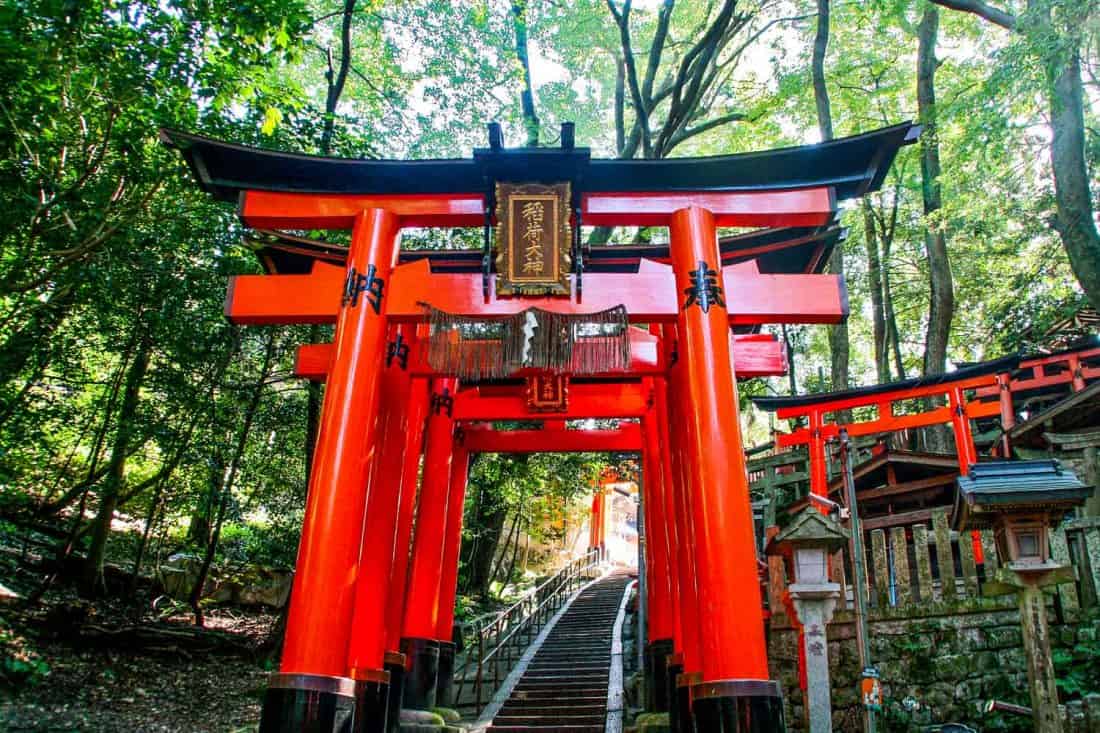
Kyoto shrines are called Jinja or Taisha and welcome you with a bright red or orange torii gate.
We came to love these colourful entrances that you find scattered all over the city at even the smallest shrines.
A shimenawa is a rope with white zigzag paper hanging from it. It is often found attached to torii gates, or even a tree, and marks the boundary to a sacred place.
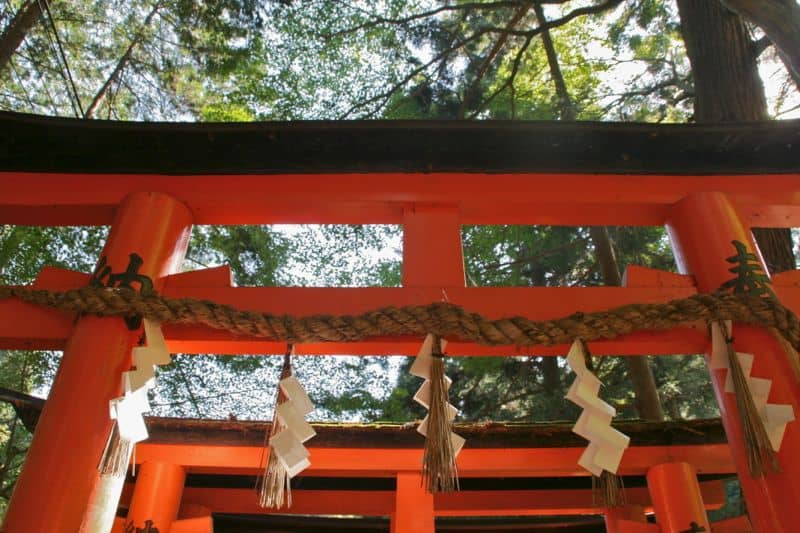
Komainu are a pair of guardian dogs or lions found at the entrance to the shrine. At Inari shrines they are foxes instead.
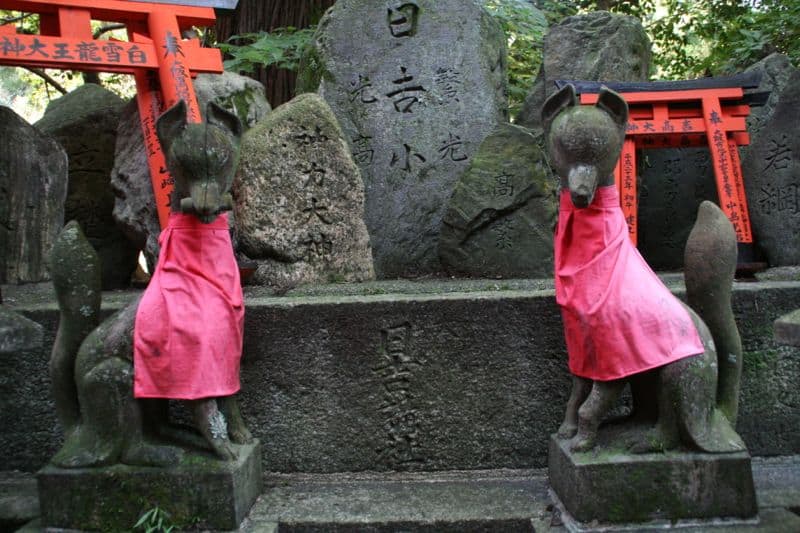
Just inside the entrance you’ll find a purification fountain to wash your hands and mouth before approaching the main hall. The water spurts out of a range of animals but a dragon is common.
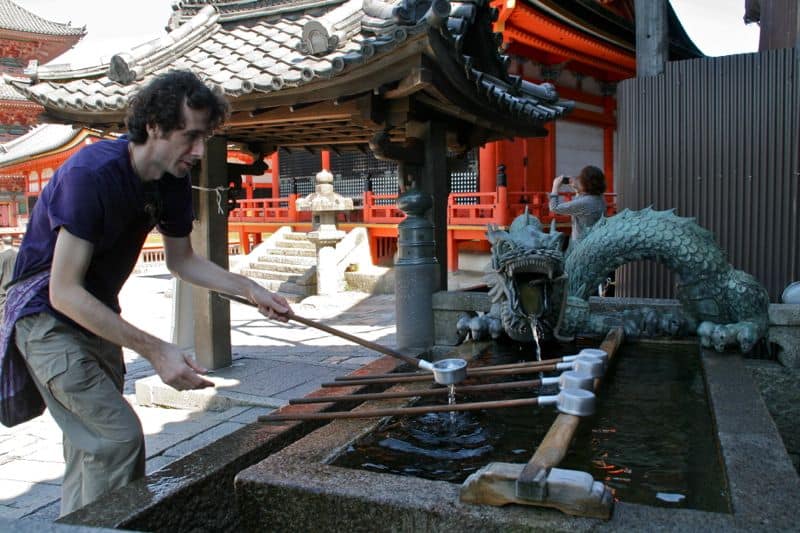
There are a number of buildings around the shrine complex including the main hall (honden) which contains a sacred object, and an offering hall (haiden) where people pray.
This is done by throwing a coin into the box as an offering, bowing deeply twice, clapping twice, bowing again and then praying.
Often there is a gong which may be used before praying to get the kami or Shinto gods’ attention.
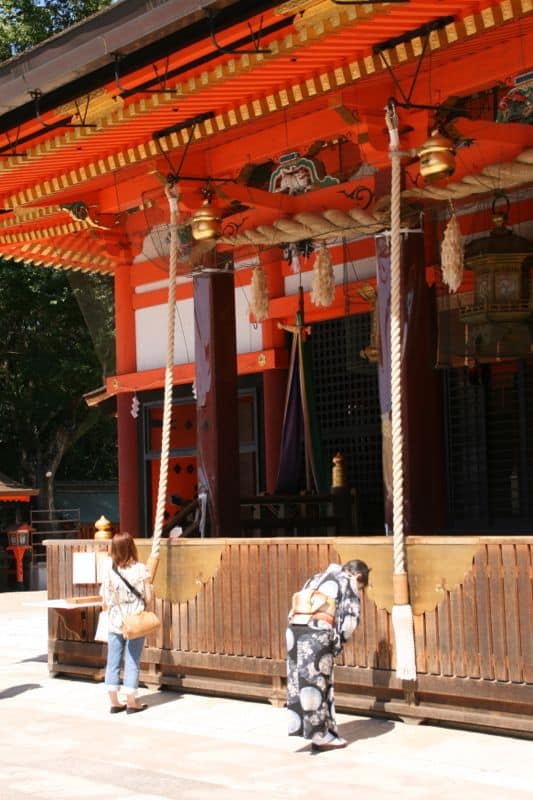
Ema are wooden plates where people leave their wishes in the hope they will come true.
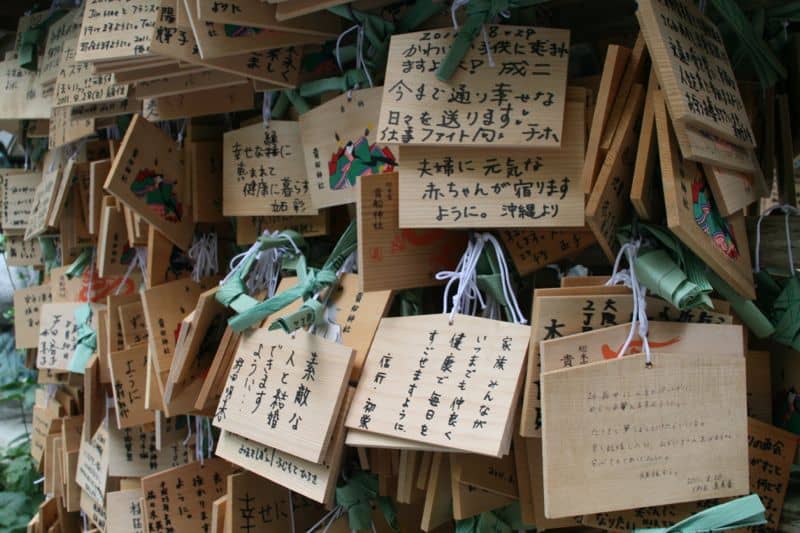
Mostly they are in Japanese, of course, but at some of the more popular temples we found a few left by tourists in English and Spanish.
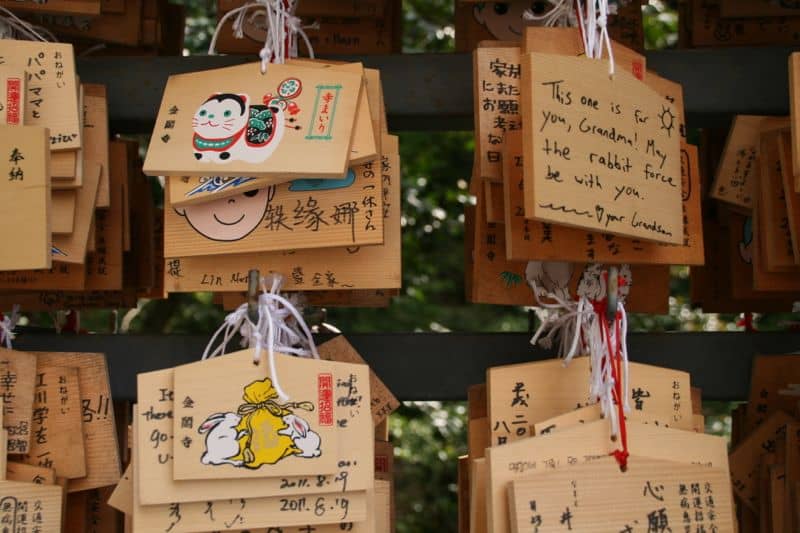
Omikuji are paper fortunes that can be bought at both shrines and temples (we got one from a vending machine at the Golden Temple).
The fortunes range from great good luck to great bad luck. There are places to tie the fortunes to avert the bad luck if you are unlucky enough to draw that fortune. If you get a good fortune, keep it with you.
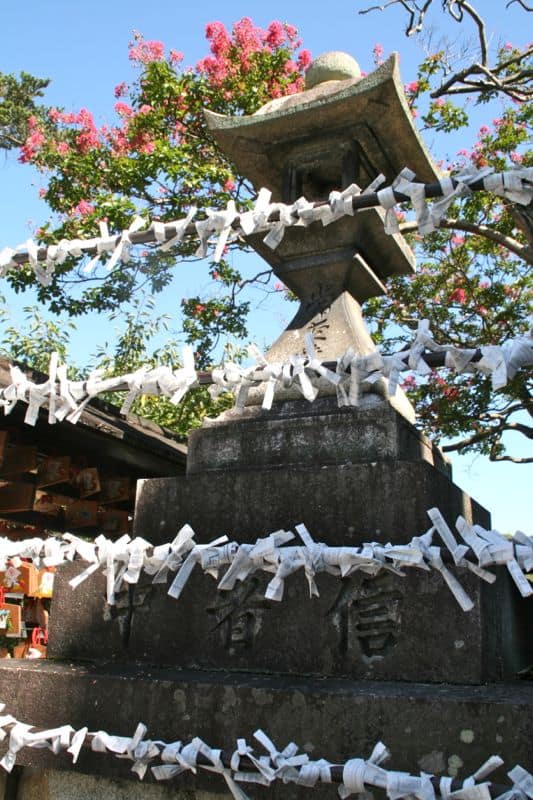
It’s worth seeking out shrines in Kyoto, although most aren’t as famous as the temples, as they are usually free, very colourful, and the rituals are fascinating to observe.
Features of Kyoto Temples
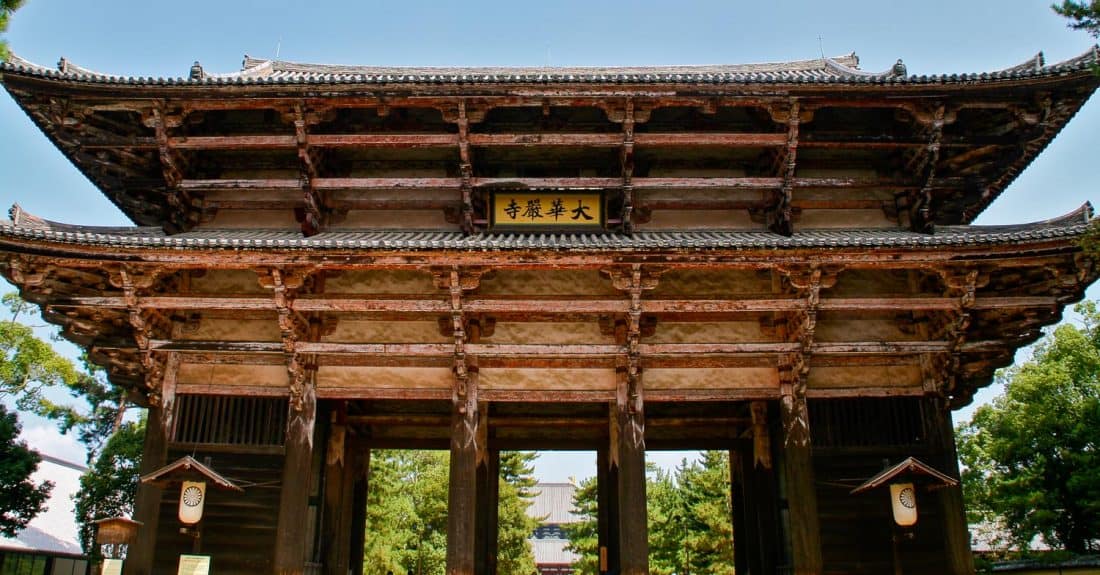
Kyoto temples are called Tera or Ji. Buddhist temple complexes feature entrance gates, but they are usually dark wood rather than the red torii gates of shrines and they are bigger structures.
The main gate features a pair of rather frightening nio or guardian statues.
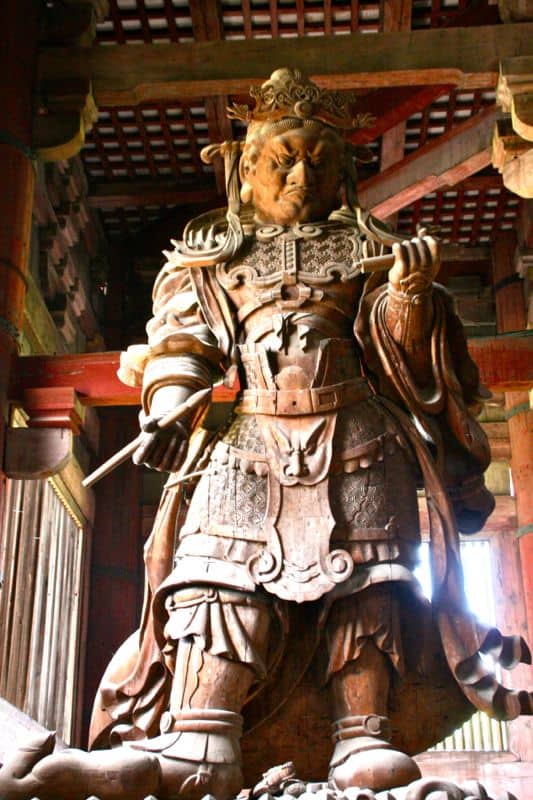
There are a number of buildings including the main hall and often a pagoda where the remains of the Buddha (or representation of) are stored. There is also a bell which is rung at New Year.
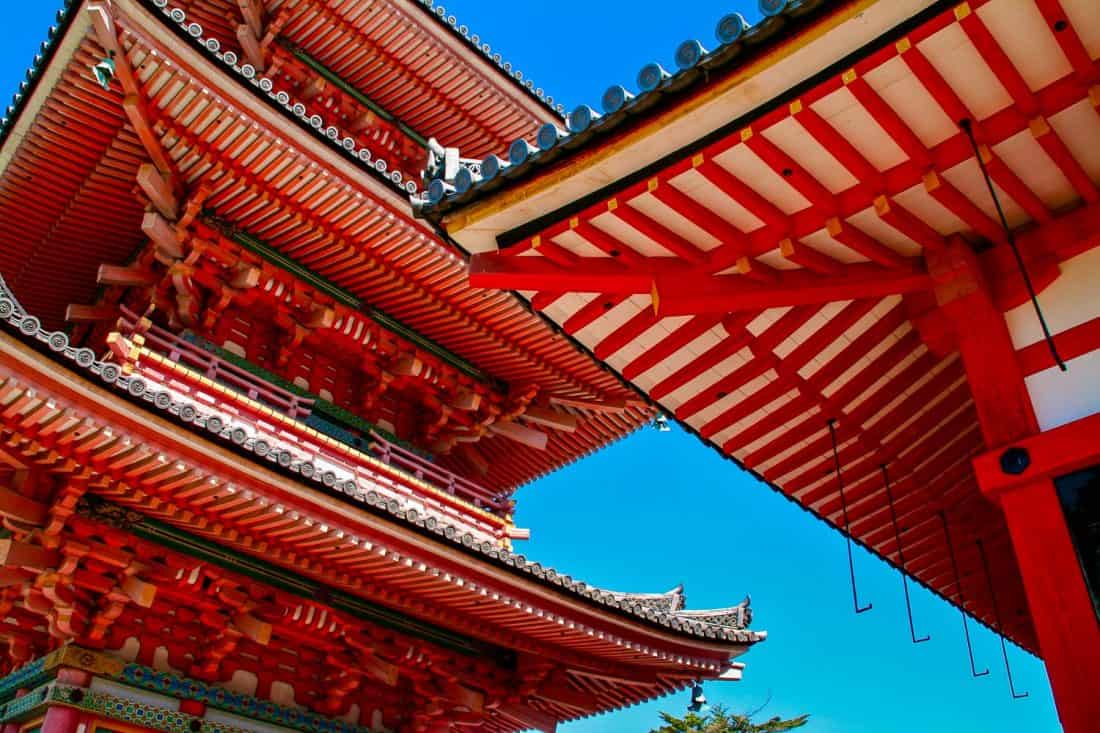
Worshippers pray at the sacred object after making an offering into the coin box. Incense is often burned.
Many temples have beautiful gardens featuring ponds, raked gravel Zen gardens, rock gardens, and peaceful walkways.
It was a fairly common feature to find ponds or pots to throw money into—testing your aiming skills in search of good luck.
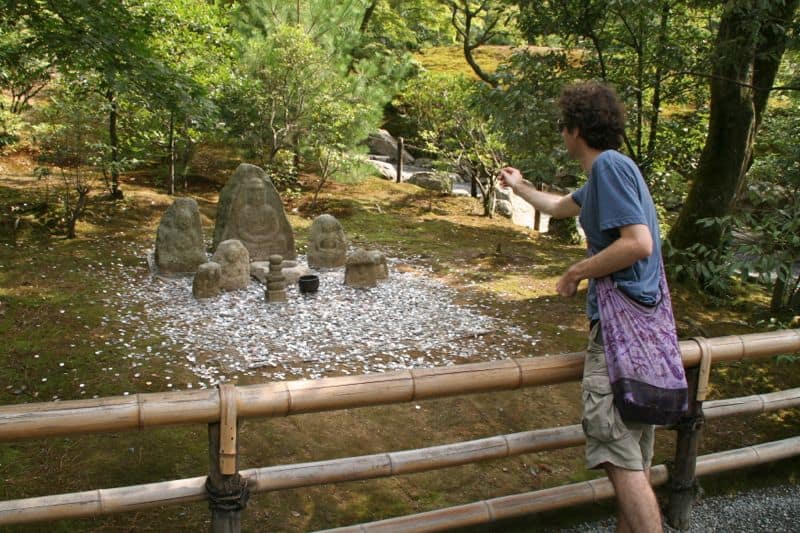
At the most touristy temples you’ll find an array of souvenir stands, and of course, the ever-present (and rather convenient) soft drink vending machines.
Northern Kyoto Temples
1) Kinkaku-ji Golden Temple
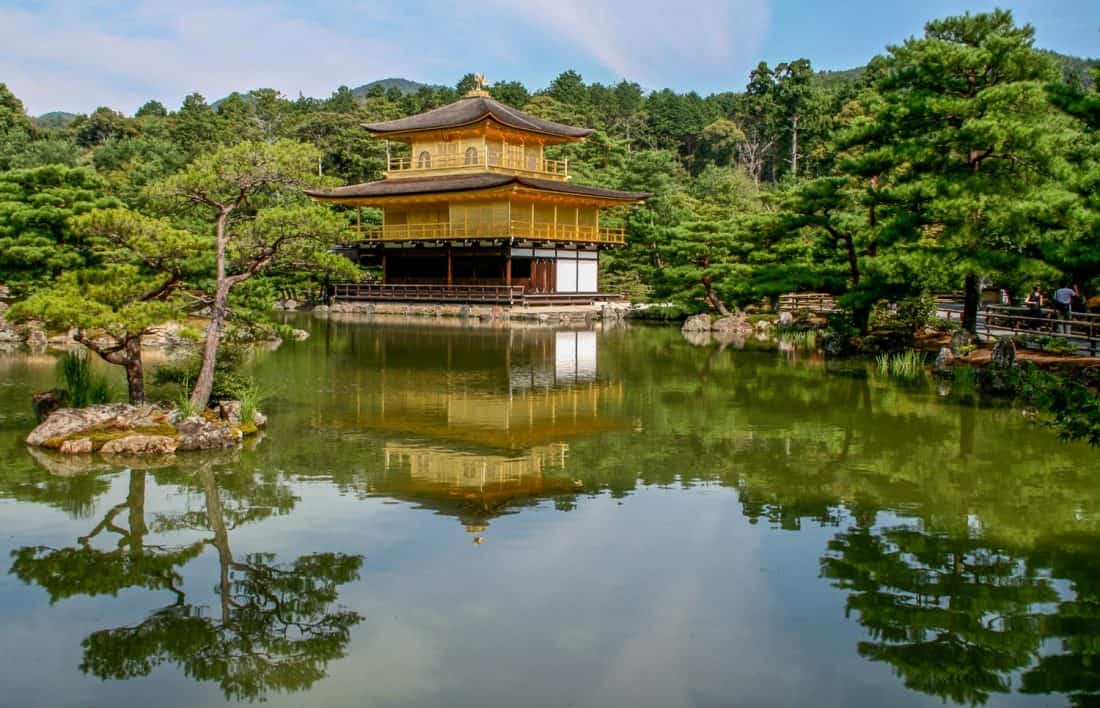
The iconic Golden Temple is one of the most famous Kyoto temples and we were prepared for it to be overrated.
Instead we couldn’t help but be impressed by the shimmering pavilion reflected in a pond dotted with islands of trees.
The pavilion features three unique styles of architecture—the first floor is palace style, the second in the style of a samurai house, and the third is Zen temple style. The top two floors are completely covered in gold leaf.
We got there early before the worst of the crowds and found the leafy gardens a peaceful place to wander.
Details: Entry fee costs 500 yen ($3.50) adult/ 300 yen ($2) child. Open 9 am – 5 pm. There are no train stations nearby. You could cycle here (like we did), take a taxi, or get the bus 101 or 205 from Kyoto Station (at least 40 minutes).
2) Kurama-dera
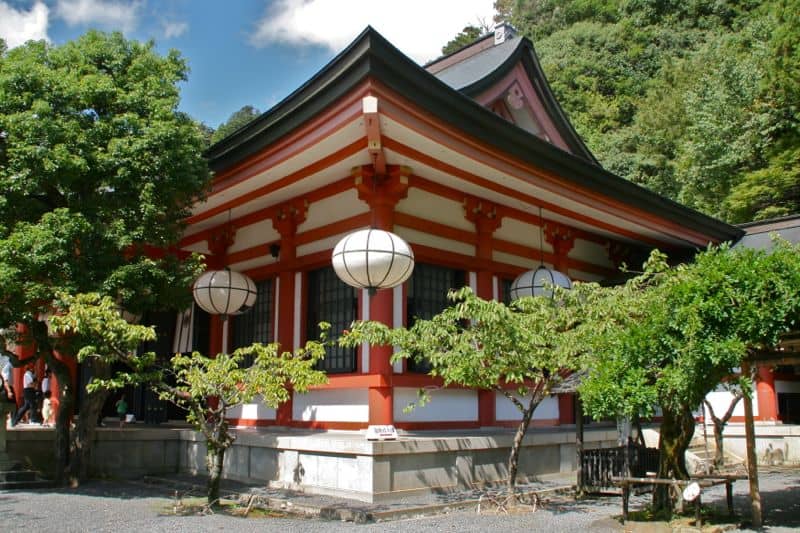
A wonderful escape from the city is to take the train 30 minutes north to Kibune or Kurama.
We started at the small riverside village of Kibune, visited the shrine there, and then walked across the valley to Kurama-dera.
This gorgeous temple was a wonderful reward after the steep 40-minute climb.
It has the best location of all the temples we visited, entirely surrounded by forest-covered hills with expansive views.
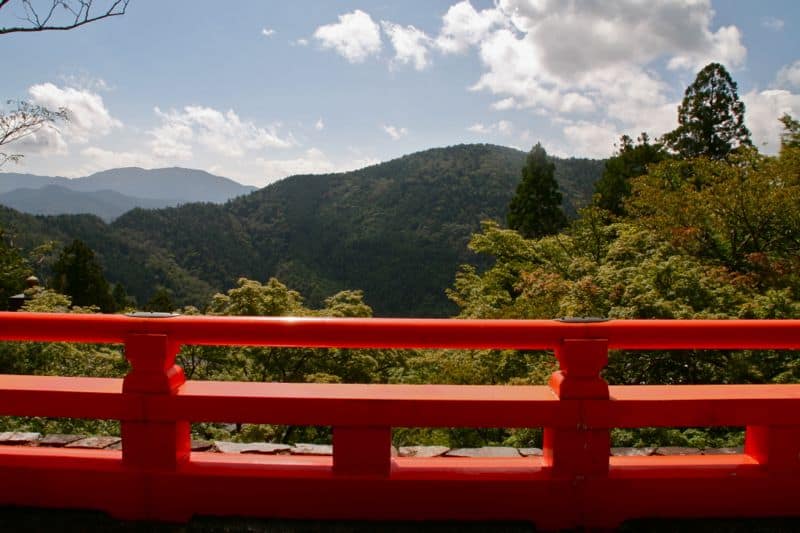
Kurama-dera is one of our favourite places to visit in Kyoto in autumn and the colours peak earlier here than in the city.
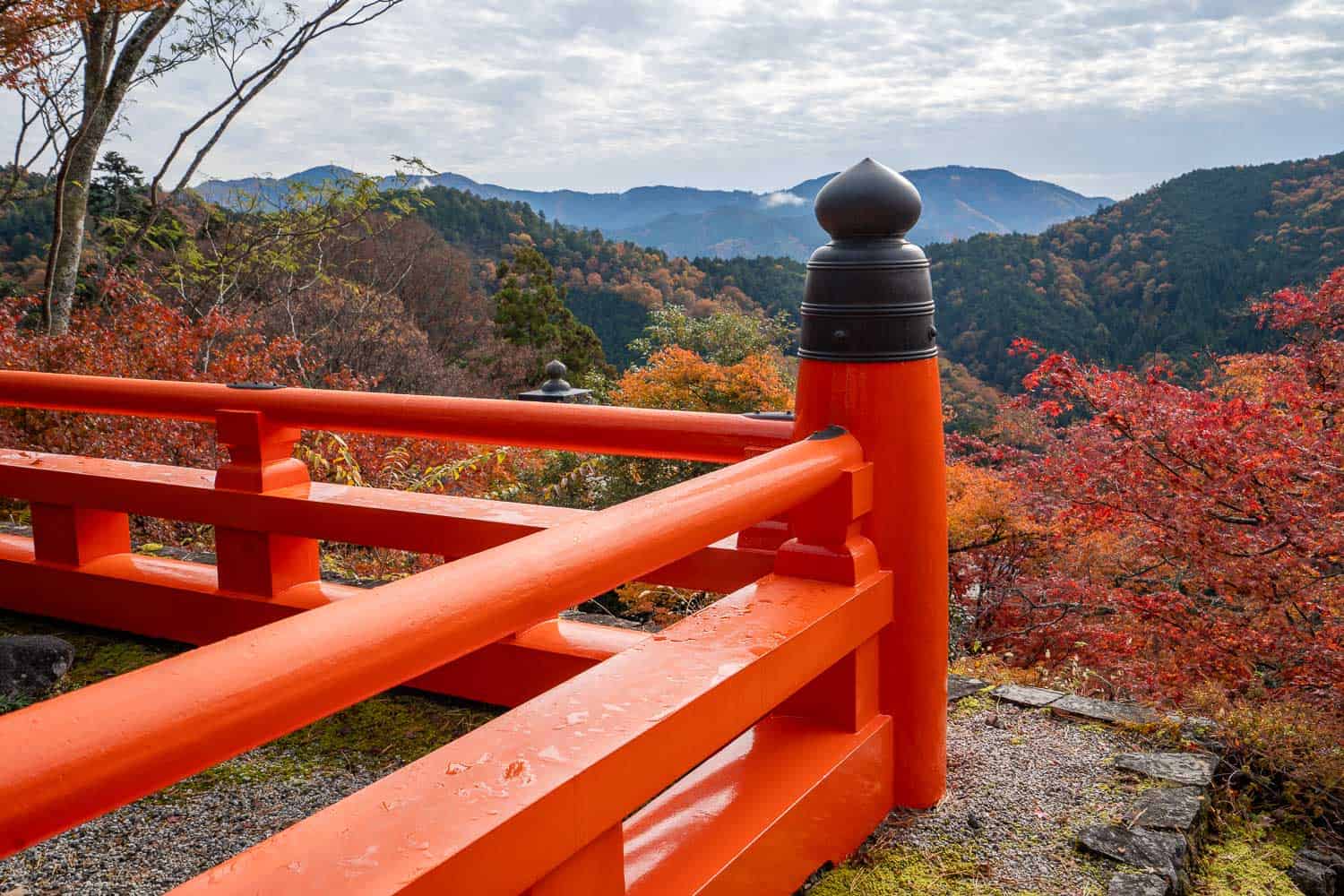
The main hall is a cheerful red with large white lanterns and there are tiny Zen rock gardens throughout the complex.
It’s easy to do this trip independently, but if you’d prefer to have a guide why not try this 1 Day Hiking Tour in the Mountains of Kyoto which includes accommodation pickup/ drop off.
Details: 500 yen ($3.50) entry fee. Open 9 am – 4.30 pm. The train on the Eizan Kurama Line from Demachi-Yanagi Station to Kibuneguchi Station takes 30 minutes.
Hike over the mountain then return on the same line from Kurama Station. Or if you don’t want to walk, take the train to Kurama and the cable car up to the temple.
Eastern Kyoto Temples – Southern Higashiyama
Southern Higashiyama in the eastern hills is one of Kyoto’s most traditional neighbourhoods with picturesque streets of old wooden houses and many temples to explore.
If you only have one day in Kyoto, you could spend it temple-hopping through these temples (from south to north) and up to Northern Higashiyama (we always do it on foot).
3) Kiyomizu-dera
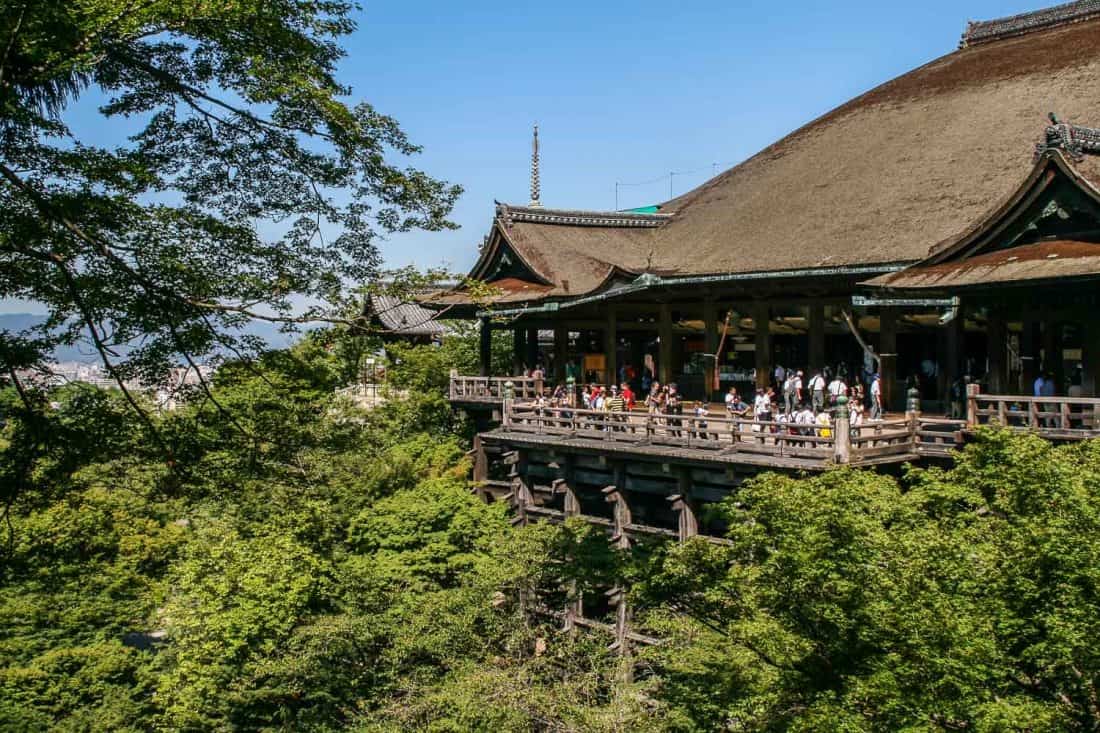
One of the most popular temples in Kyoto, Kiyomizu-dera is usually crowded with school and tour groups and the many souvenir shops add a more commercial air.
It’s still a beautiful place, though, with an impressive location overlooking the city, and you can walk down a quiet path into the forest where the cicadas drown out the school kids in summer.
Visit before 8am to avoid the crowds, especially in November as it’s a top place to see autumn leaves in Kyoto.
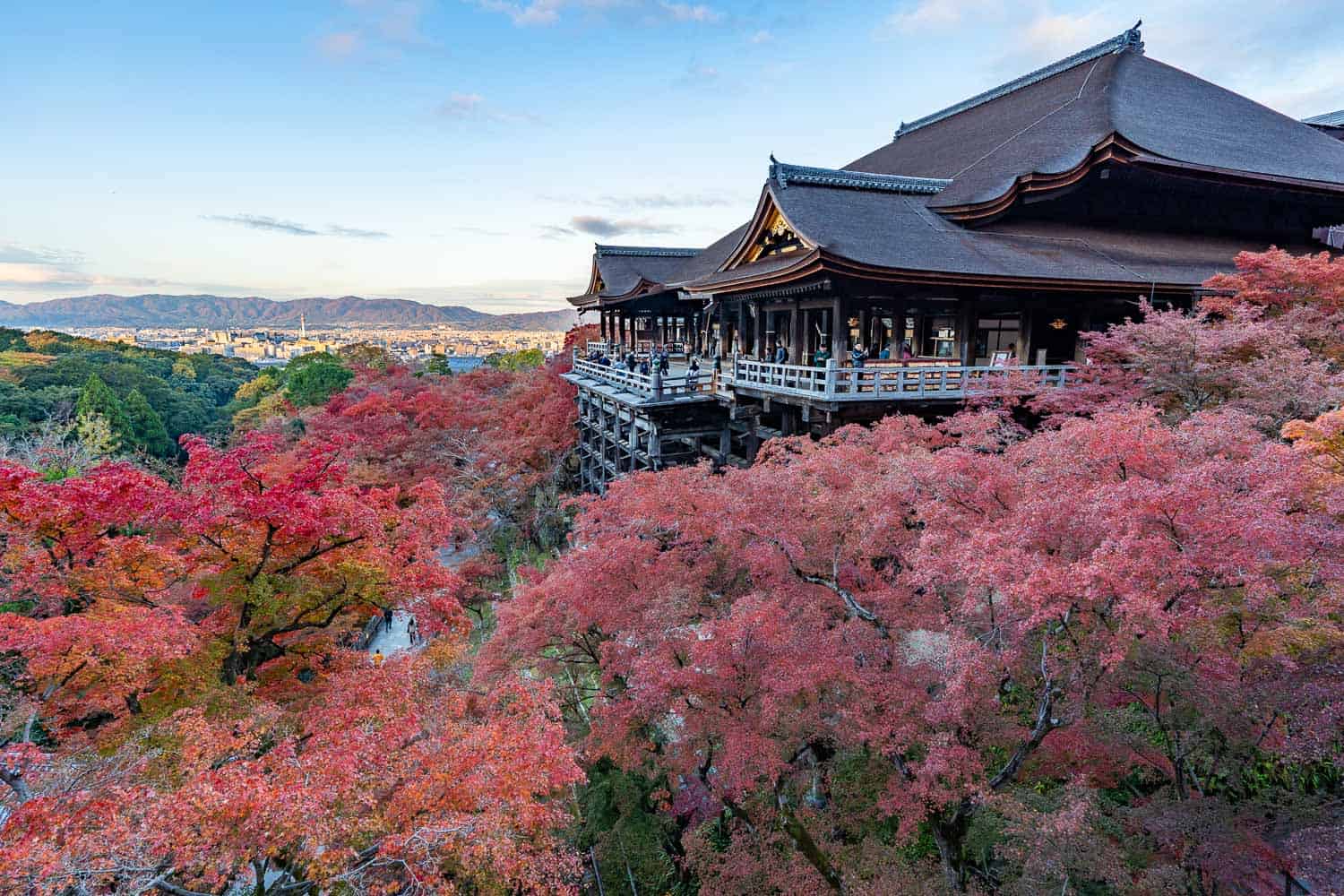
It’s also worth visiting during the special night illuminations that take place in March, April, and November, but we found November very busy.
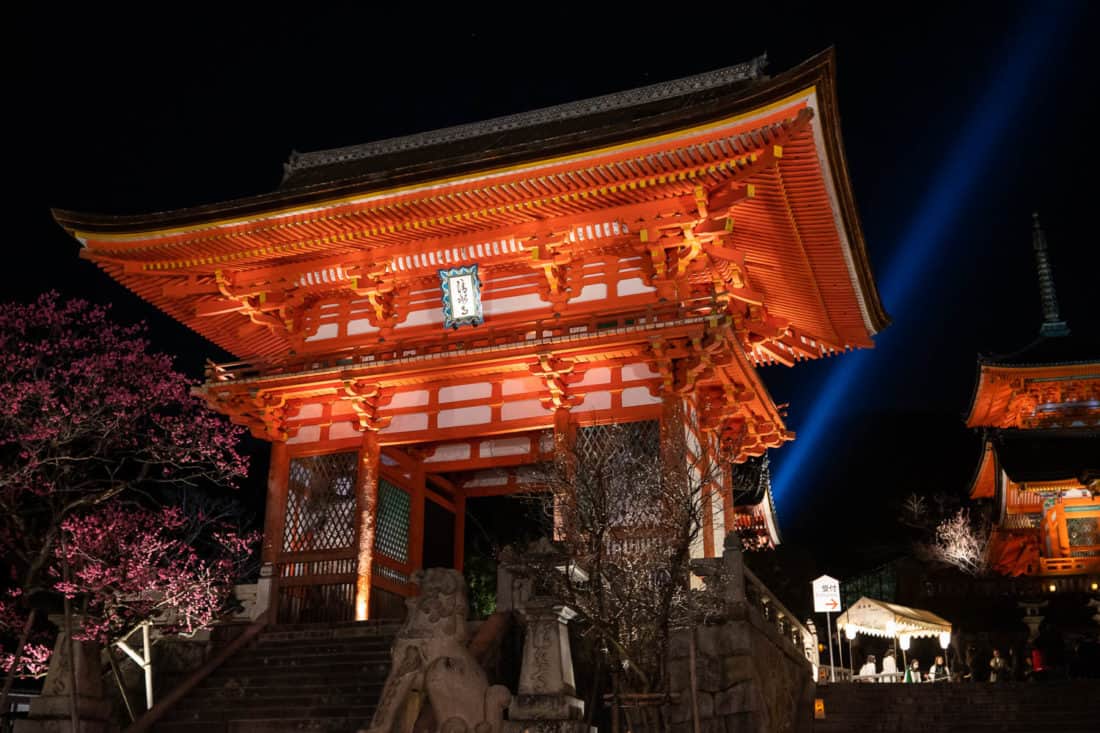
The large wooden main hall was built without nails and houses a statue of the eleven-faced, thousand-armed Kannon.
One of the most interesting things about the temple is the Tainai-meguri to the left of the temple entrance. It costs an extra 100 yen, but it’s worth it for the bizarre experience.
After taking off your shoes, you enter a dark hallway and continue into complete pitch blackness. It’s rather disorientating and you have to cling to the handrail to follow the path.
Apparently, you are figuratively entering the womb of Daizuigu Bosatsu, a female Bodhisattva who has the power to grant wishes.
After a few minutes in darkness, you reach a gently lit large round stone where you place your hand to make a wish.
Details: 500 yen ($3.50) entry fee. Open 6 am – 6 pm. It’s a 20-minute walk from Kiyomizu-Gojo Station on the Keihan Main Line. Walking up through the atmospheric lanes full of souvenir shops is part of the fun.
4) Kodai-ji
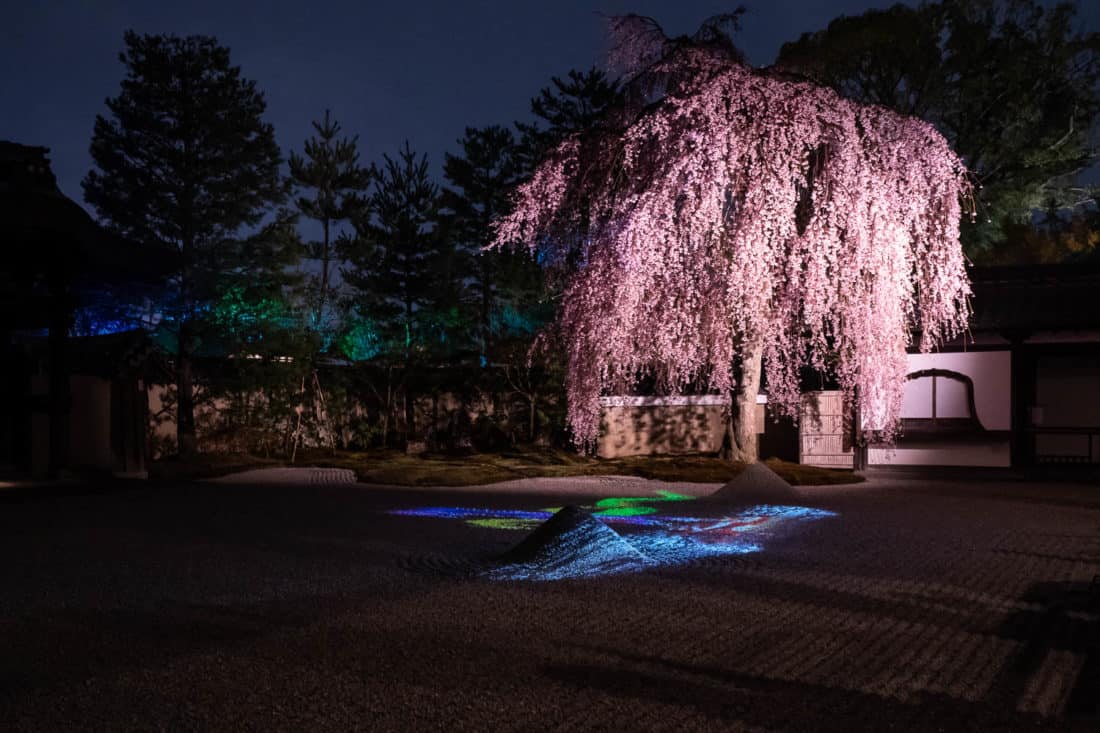
Kodai-ji is in a convenient location to combine with other major attractions, but it doesn’t get too busy, especially if you visit in the morning.
The Zen Buddhist temple was established in 1606. The main hall features beautiful artwork and painted screen doors.
It overlooks a raked gravel garden with a weeping cherry tree.
You’ll also find a lovely strolling garden with a pond, attractive teahouses, and a bamboo grove (which we enjoy much more than the famous one in Arashiyama).
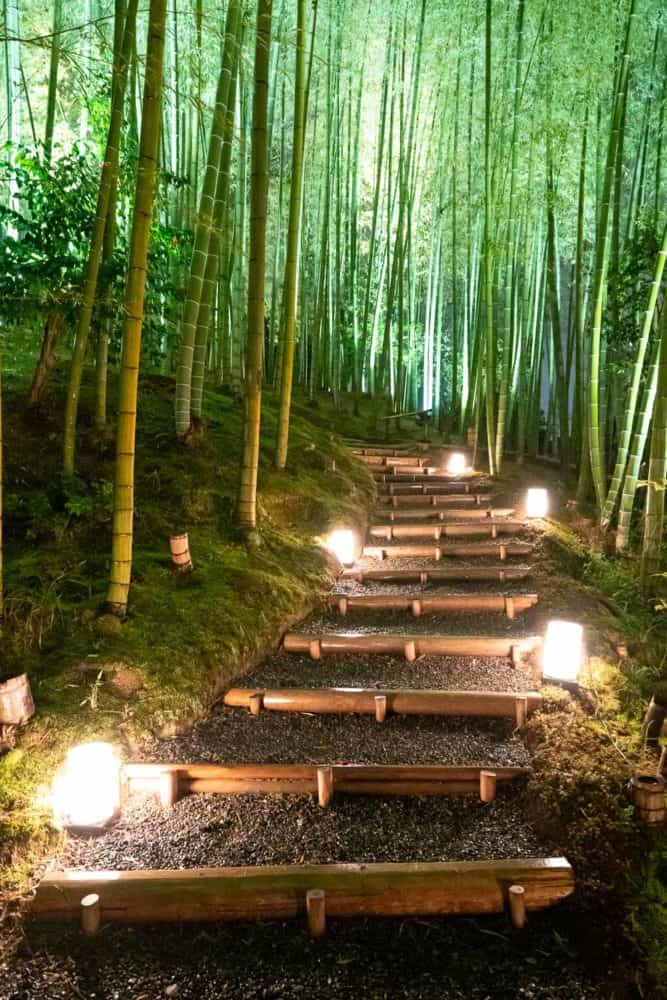
Three times a year (April, August, and November) the temple opens for special night illuminations, which are well worth visiting although it’s much more crowded.
It’s one of our favourite Kyoto cherry blossom spots.
Details: Entry fee is 600 yen ($4.50) adult/ 250 yen ($2) child (or 900 yen ($7) combo ticket with Entoku-in). Open 9 am – 5 pm. It’s a 15-minute walk from Gion-Shijo station or a bus will get you closer.
5) Entoku-in
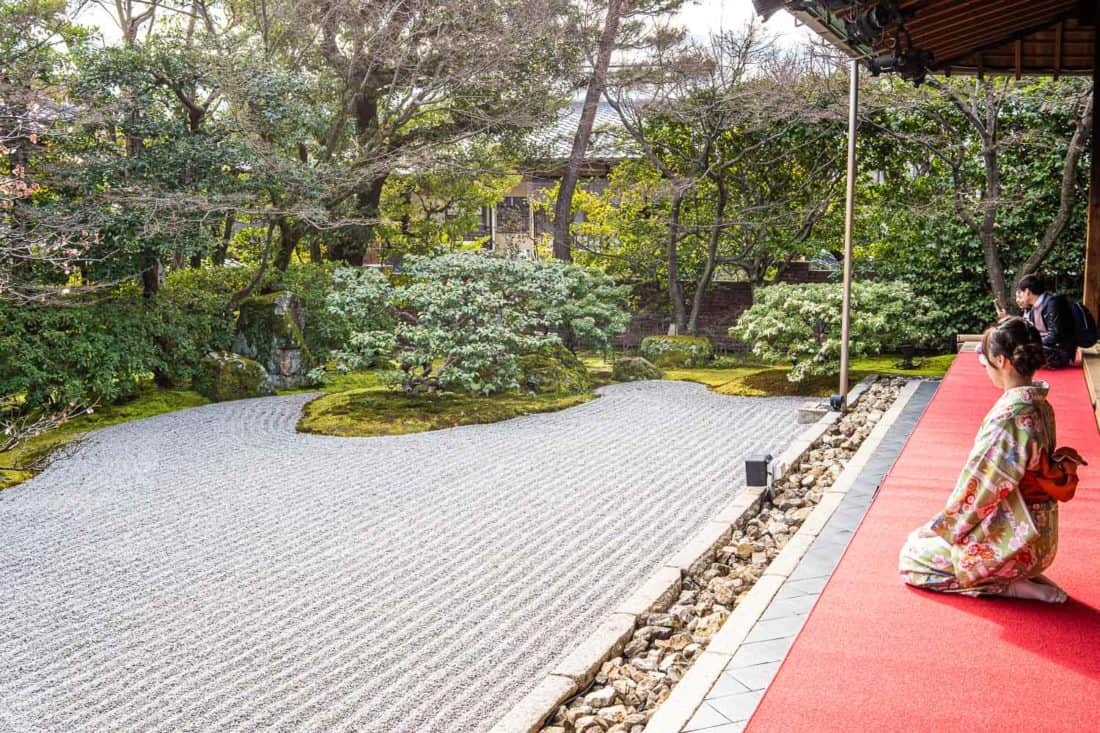
Entoku-in is a sub-temple of Kodai-ji with a small karesansui (dry stone) garden and some beautiful screen paintings. It’s usually fairly quiet here.
We enjoyed the interactive elements—make your own miniature raked stone garden, trace a Buddha picture or sutra, or try zazen meditation.
You can also enjoy a matcha and sweet overlooking another small stone garden at the end of your visit (500 yen). I had this room to myself for a while and it was lovely and peaceful.
Details: Entry fee is 500 yen ($4) adult/ 200 yen ($1.50) child (or 900 yen ($7) combo ticket with Kodai-ji). Open 10 am – 5 pm. It’s a two-minute walk from Kodai-ji.
6) Kennin-ji
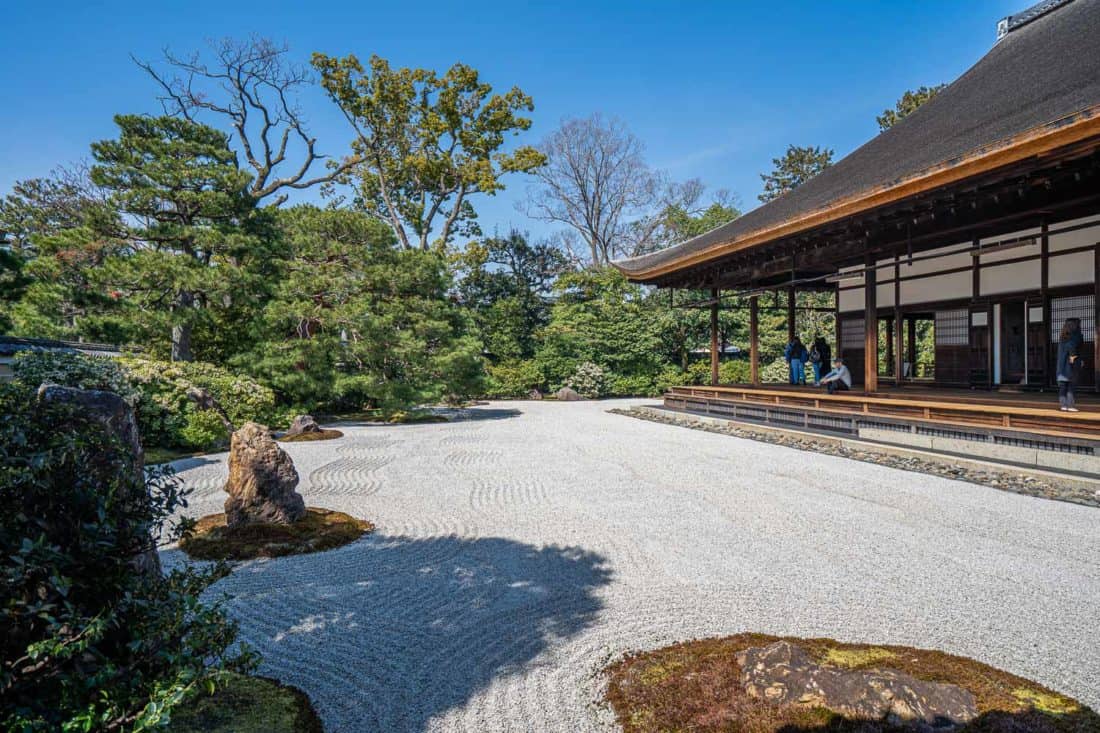
Kennin-ji is another quieter temple in Gion. It was founded in 1202 and is the oldest Zen temple in Kyoto.
You can wander the large complex for free, but it’s much better inside.
The main building overlooks a large raked gravel garden, one of the best we visited.
There are lots of small rooms where you can admire screen paintings and you can walk in the gardens to an old teahouse.
In a separate building there’s a gorgeous ceiling painting of twin dragons that was painted to celebrate the temple’s 800th anniversary in 2002.
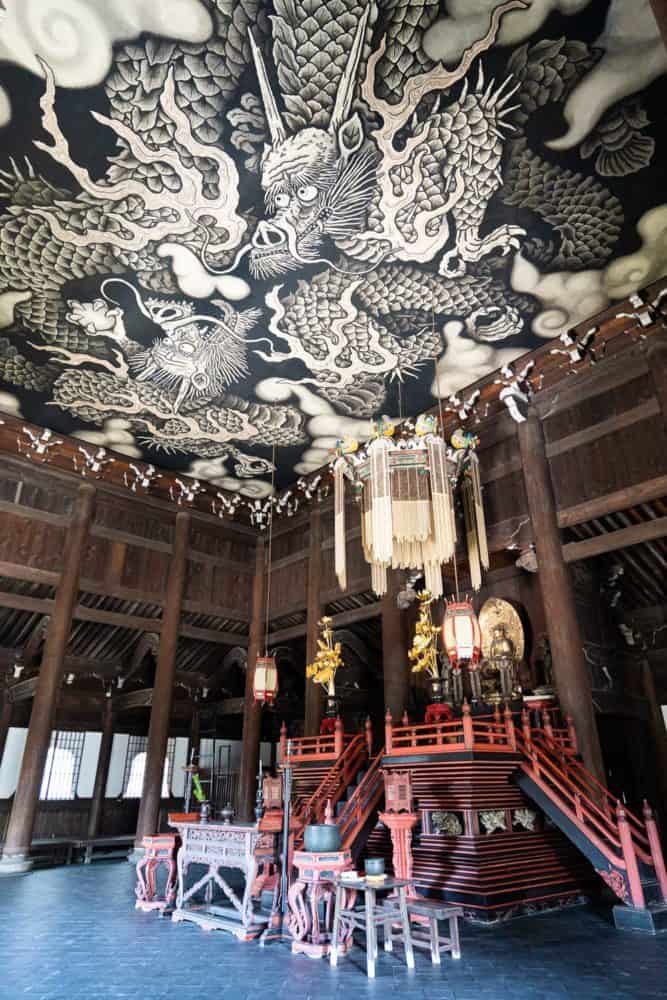
Details: Entry fee 800 yen ($6) adult/ 500 yen ($3.50) for students. Open 10am – 4.30pm. Gion Shijo is the nearest station.
7) Yasaka-jinja
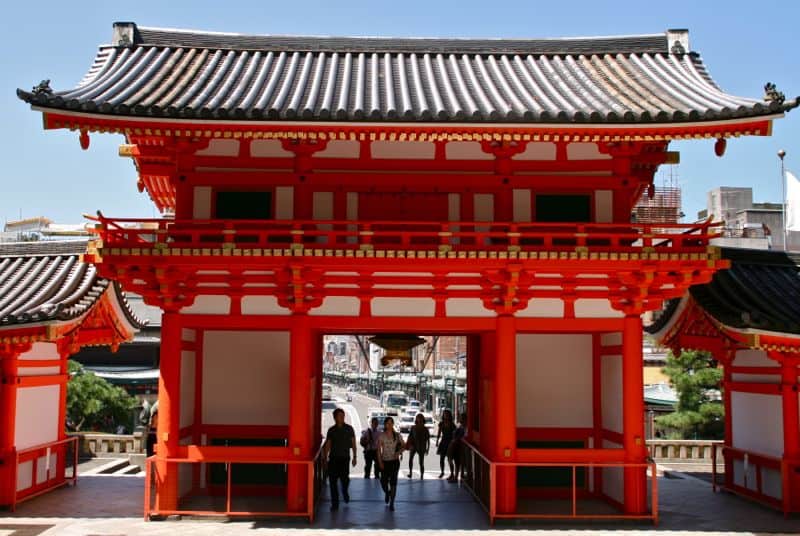
Yasaka-jinja is in Gion and is considered the guardian shrine of this geisha quarter.
You enter through a huge torii gate (one of the tallest in Japan). It’s especially magical at night when the lanterns are lit up.
Details: Free entry. Open 24 hours. The closest train stations are Gion Shijo Station on the Keihan Line and Kawaramachi Station on the Hankyu Line.
8) Chion-in
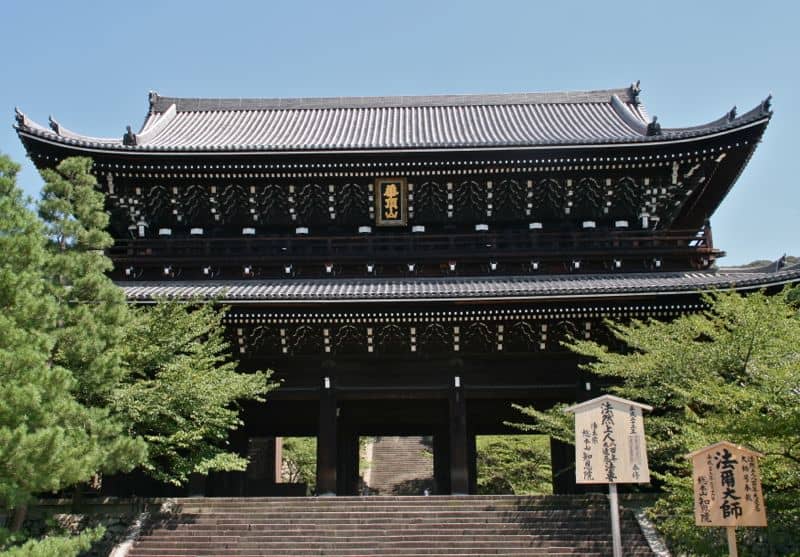
At Chion-in a giant wooden gate (the largest in Japan) leads to steep stone steps up to the main temple complex which has a lovely backdrop against the green mountains.
The main hall is huge and inside is a large tatami room (no shoes or photography) where we sat quietly listening to the monks chant.
People approached the ornate golden altar to make their offering, ring the bell, and pray. They also lit incense and tea light candles flickered in the semi-darkness.
We found it a peaceful place with far fewer visitors than other temples in the area.
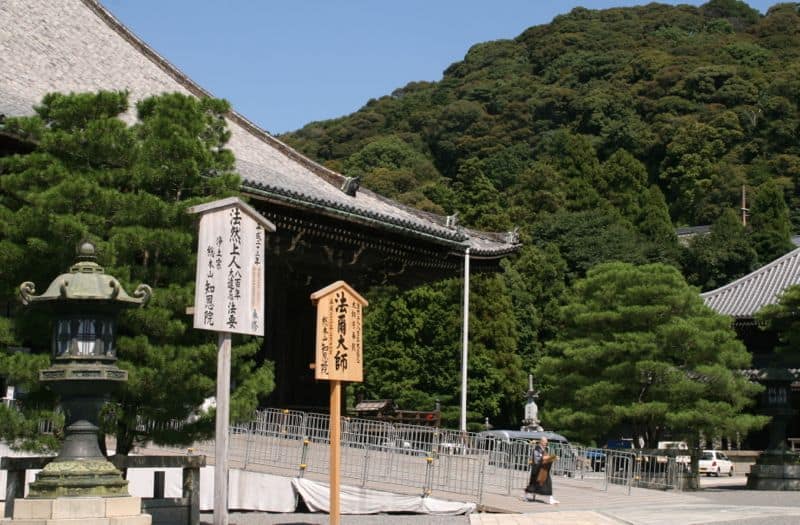
Details: Free entry. Grounds open 24 hours. Temple buildings open 9 am – 4 pm. The closest subway station is Higashiyama Station on the Tozai Line.
Eastern Kyoto Temples – Northern Higashiyama
9) Nanzen-ji
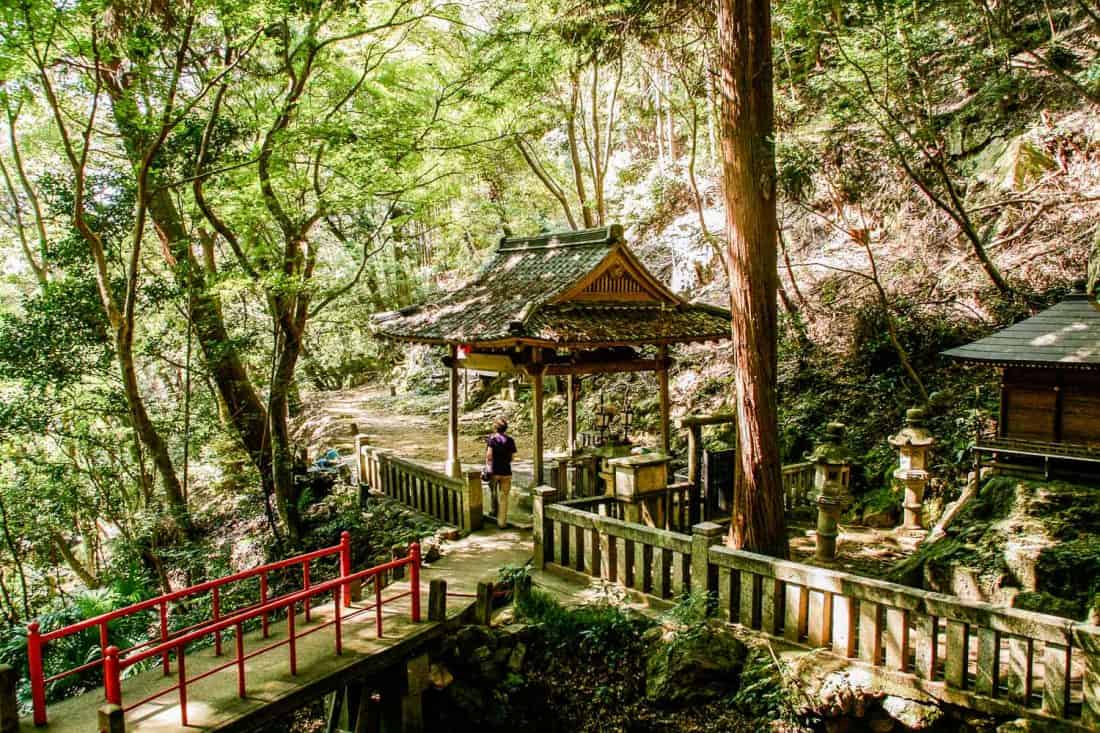
Nanzen-ji is an extensive complex of sub-temples leading off quiet, shady lanes.
The grounds are free so it’s definitely worth stopping by before you walk the nearby Philosopher’s Path.
You can see the massive Sanmon entrance gate, a large brick aqueduct built during the Meiji period, and walk up the hill into the forest to visit the simple shrine Nanzen-ji Oku-no-in beside a small waterfall (it’s always quiet up here).
You can also pay to enter some of the sub-temples. We visited Tenjuan and had the beautiful gardens to ourselves. It was especially beautiful in autumn.
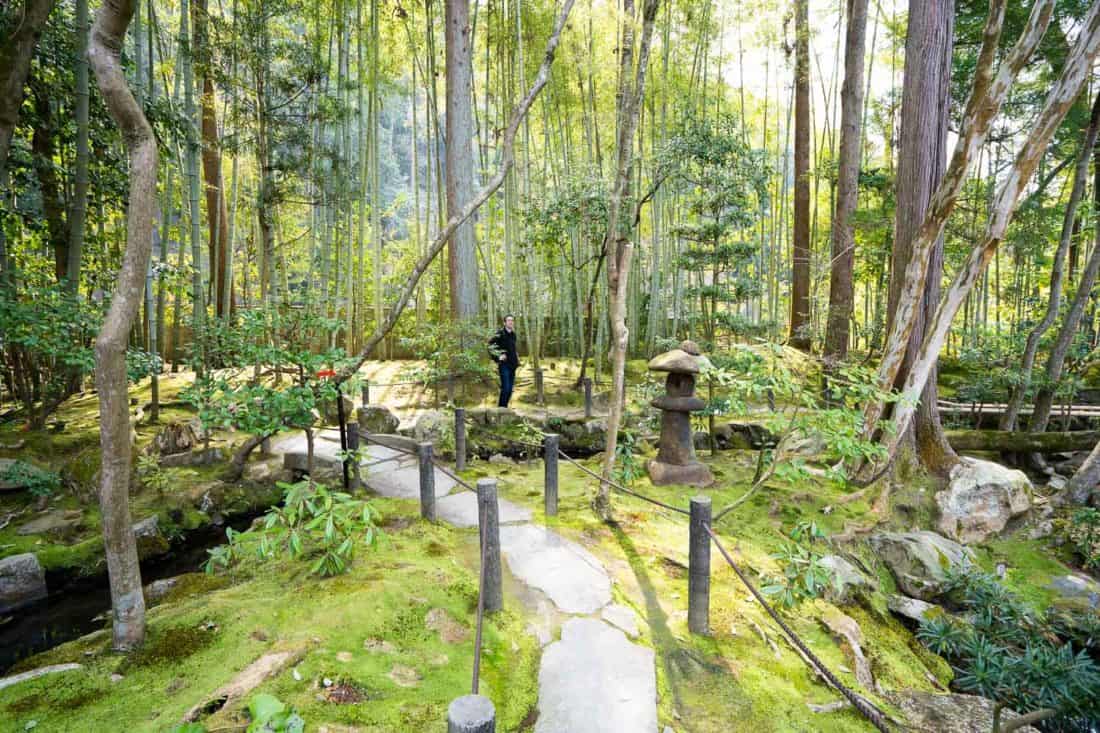
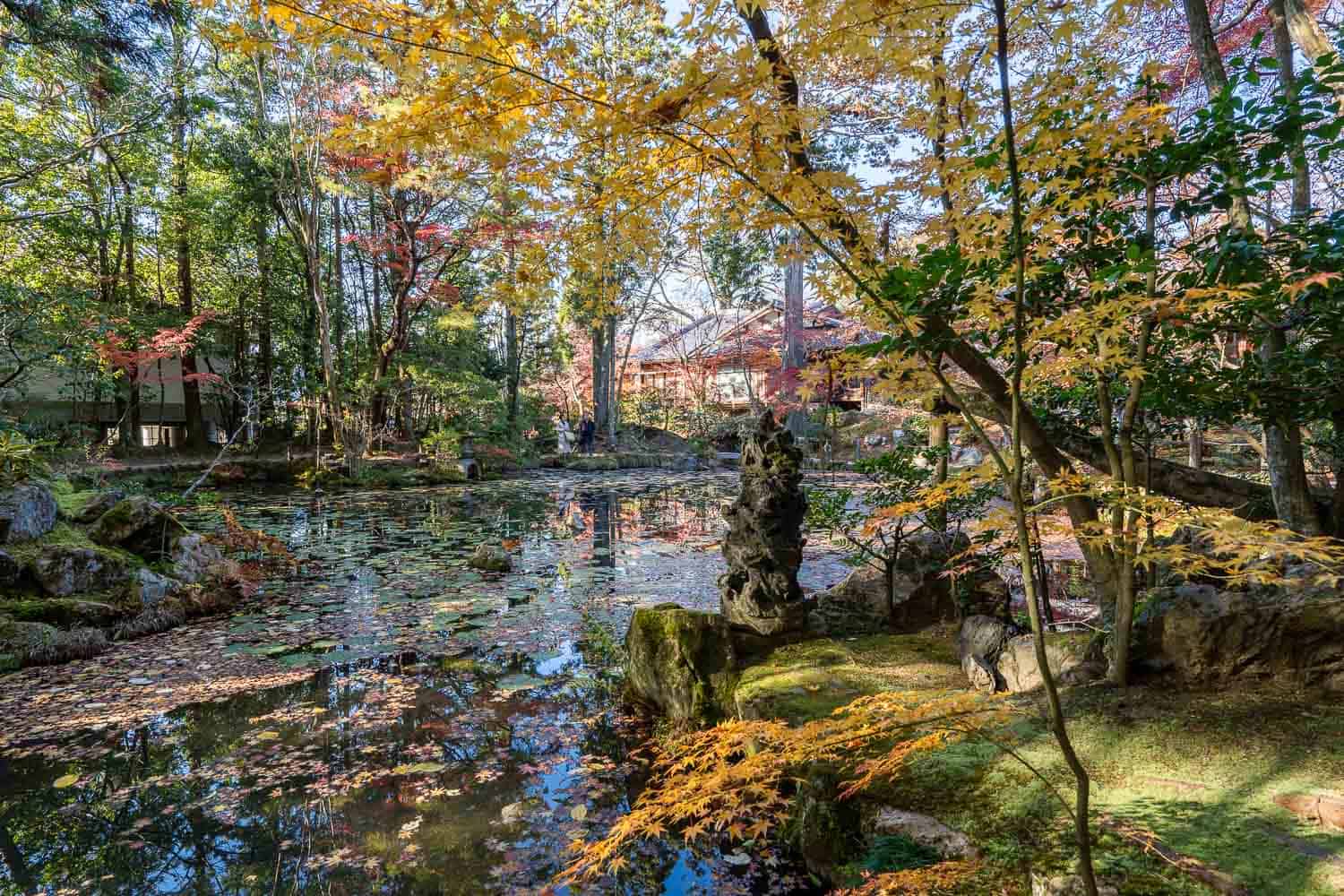
Details: Grounds are free. 500 yen ($3.50) to enter Tenjuan which is open 9 am – 5 pm. The nearest subway station is Keage Station on the Tozai line. We usually walk from Gion and continue along the Philosopher’s Path.
10) Eikando
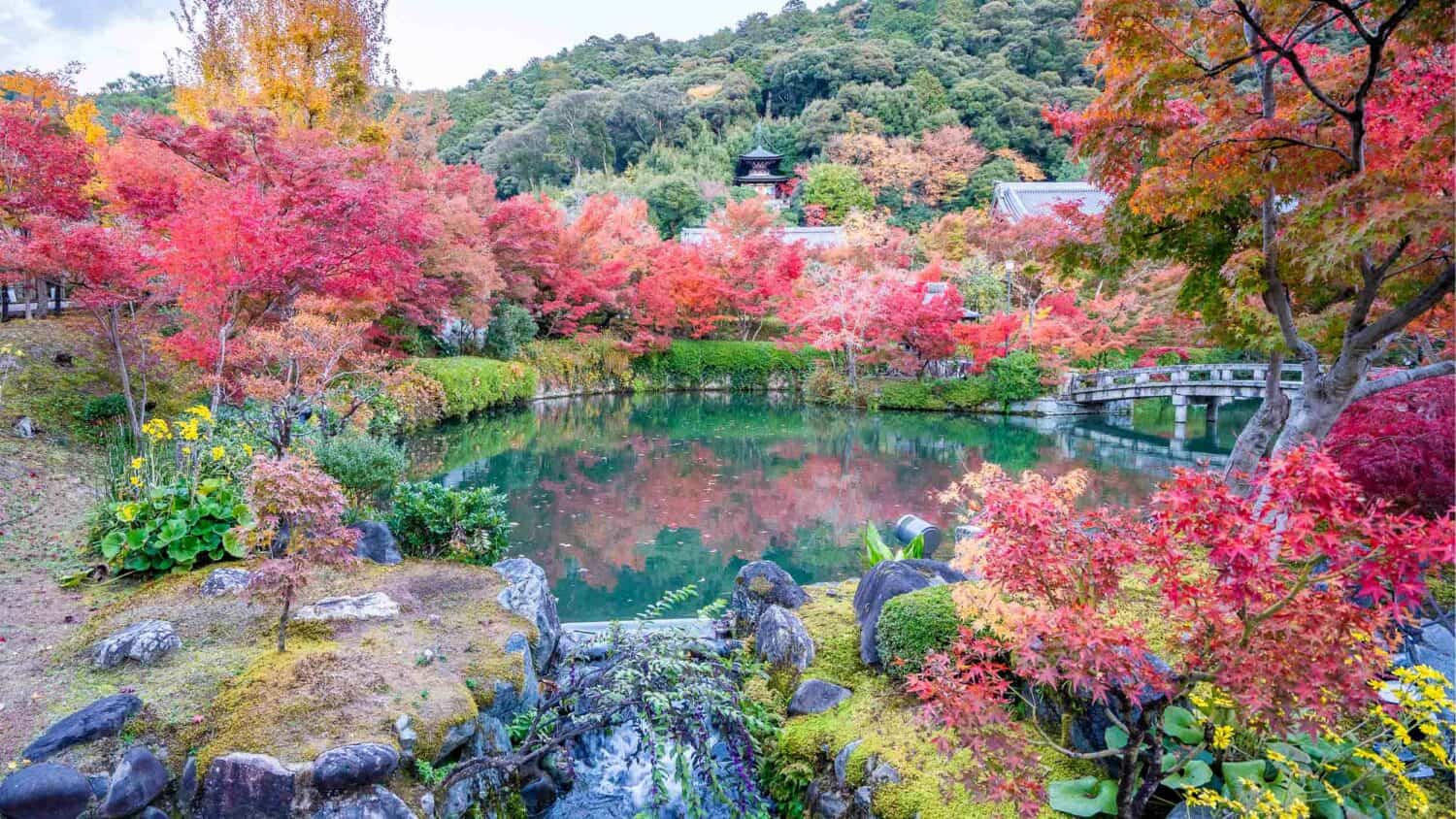
Another wonderful temple close to Nanzenji and the Philosopher’s Path is Eikando (also called Zenrinji).
This varied temple features extensive wooden buildings, a pond, and hilltop pagoda with a view of the city.
It’s quiet most of the year until late November when it becomes one of the best autumn destinations in Kyoto. The colours are truly stunning.
The night illuminations in autumn are also very popular.
Details: 600 yen ($4) entrance (1000 yen in autumn). Open 9am – 5pm.
11) Honen-in
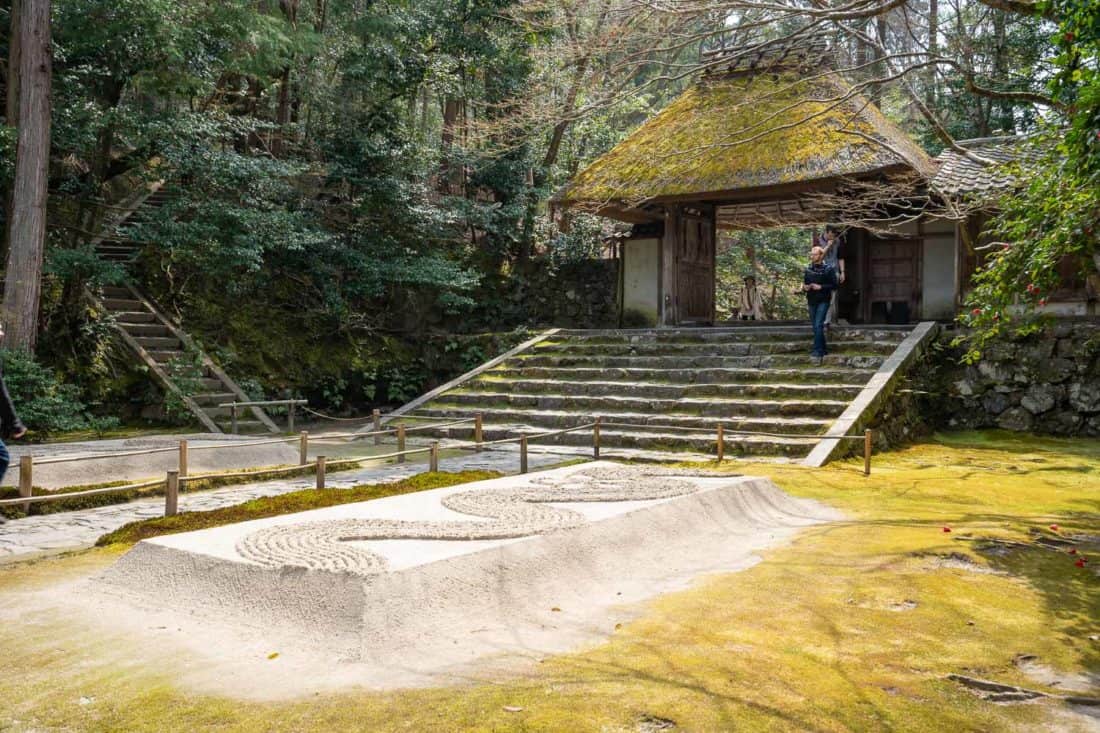
After visiting Nanzen-ji and Eikando, I recommend walking along the lovely Philosopher’s Path beside a cherry-tree-lined canal to Ginkaku-ji (see below).
Along the way you can stop at the small, peaceful temple Honen-in.
There’s a small gallery showing contemporary art exhibitions, a moss-covered gate, a stone bride over a pond, and a pretty moss garden.
It’s considered a hidden gem, but I think the secret is out now as it was fairly busy when we visited (perhaps due to the unusual free entrance).
Details: Free entry. Open 6 am – 4 pm. Best visited on foot.
12) Ginkaku-ji
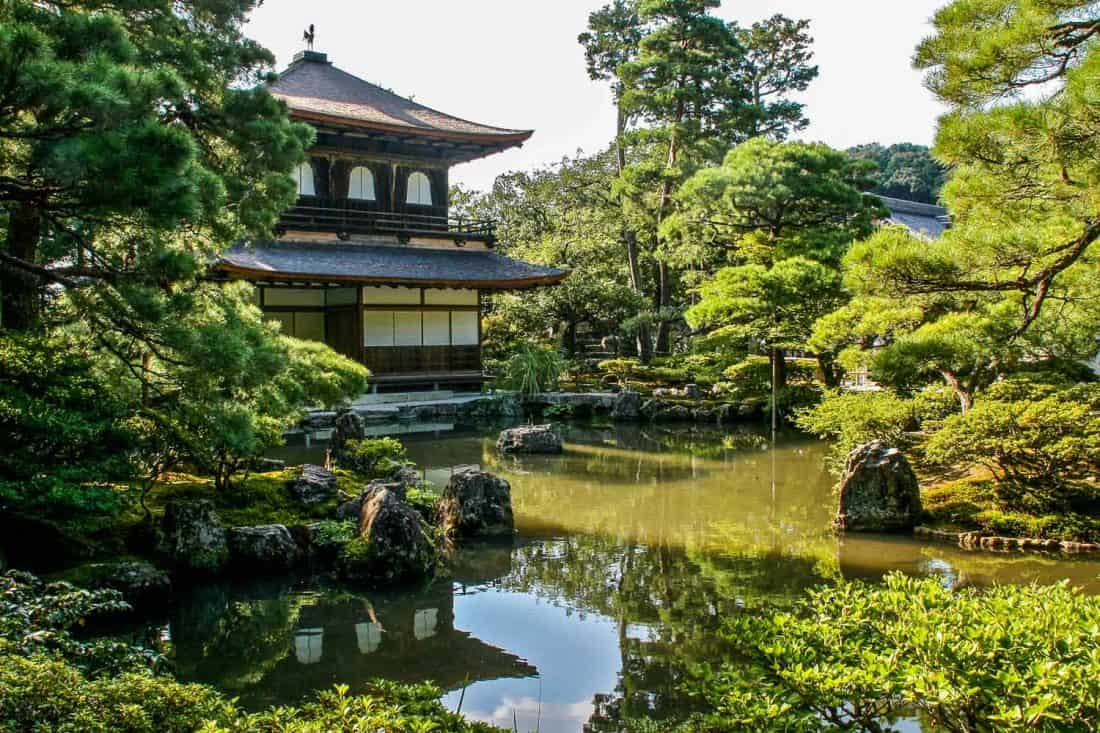
At the end of the Philosopher’s Path is Ginkaku-ji, which means Silver Pavilion, but it was never covered with silver leaf.
It’s still a lovely temple reflecting into a pond with beautiful gardens to wander through including the immaculately raked white sand of the Zen garden.
Follow the path up to a shady mossy section within the forest and admire the temple from above.
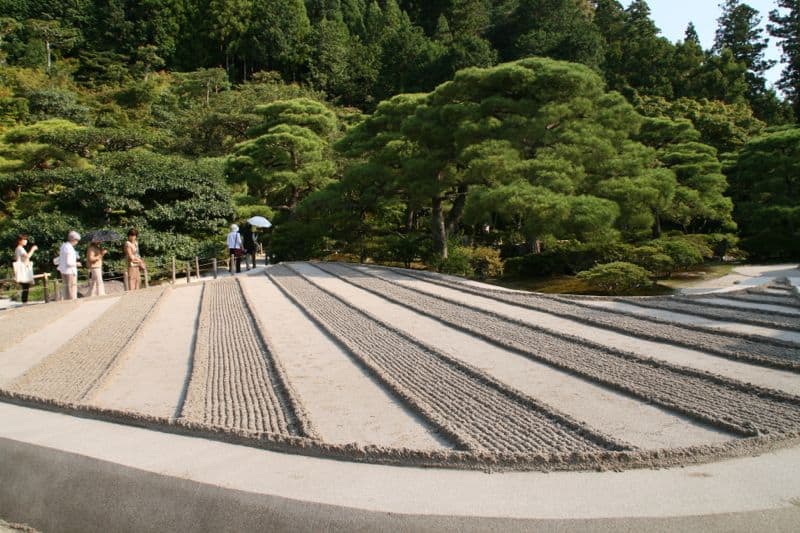
It’s another popular temple and gets quite crowded. The street leading up to the temple is packed with touristy shops selling green tea ice cream, rice crackers, pickles, pretty fans, and other souvenirs.
This is a good temple to visit in the last hour of opening. If you manage to get a reservation at Monk Kyoto (one of our favourite restaurants), you could have an early dinner afterwards (it’s a 10-minute walk away).
Details: Entry fee 500 yen ($3.50) adult/ 300 yen ($2) child. Open 8.30am – 5pm. It’s best reached by walking the Philosopher’s Path or you can take bus 17 or 100 from Kyoto Station (40 minutes).
13) Yoshida-Jinja (and Takenaka Inari)
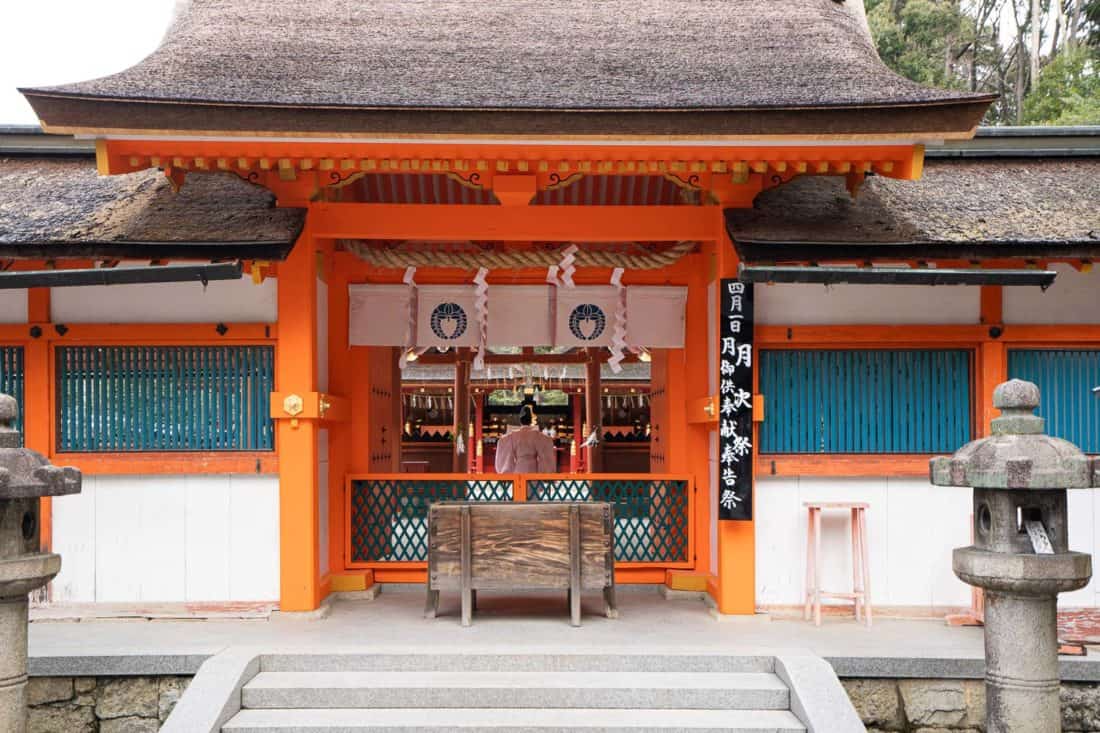
If you want to escape the crowds in Kyoto, I highly recommend heading to Yoshida Hill near Kyoto University where there are a cluster of peaceful shrines and temples (all with free entry).
We reached this area on foot after walking along the Philosopher’s Path from south to north.
We started at Takenaka Inari Shrine which is small but well worth visiting in sakura season to see the line of torii gates framed by cherry blossom trees.
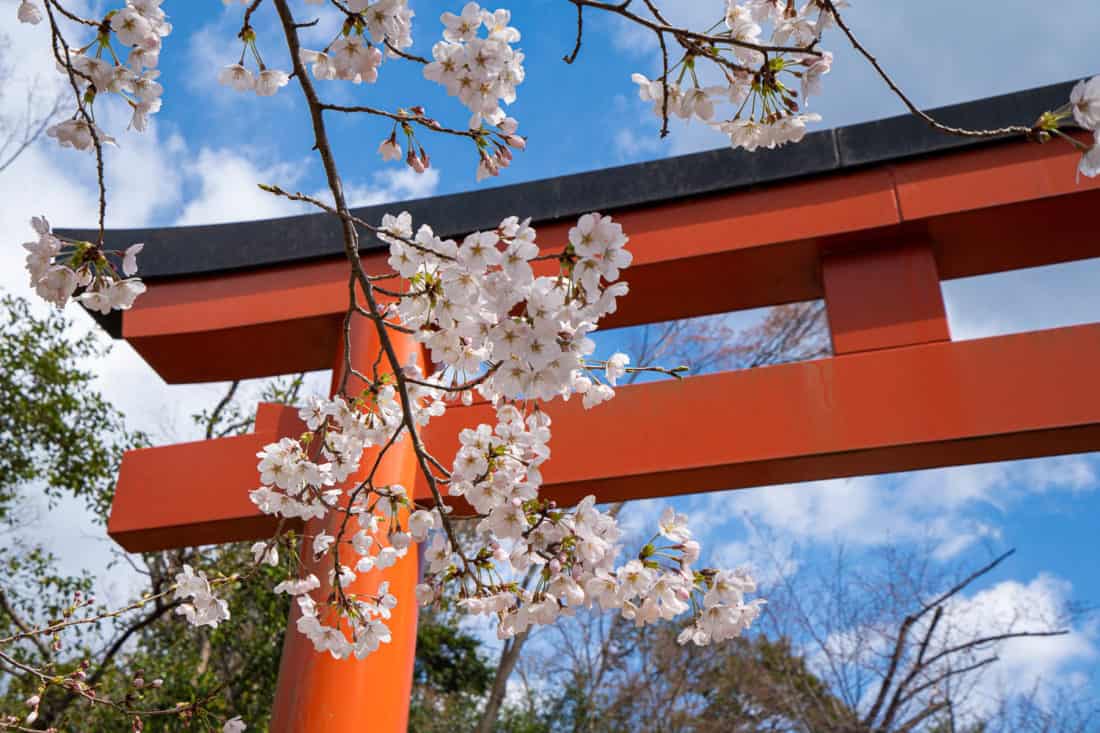
From here it’s a short walk over the hill to Yoshida-jinja, a larger shrine complex in a peaceful forest setting.
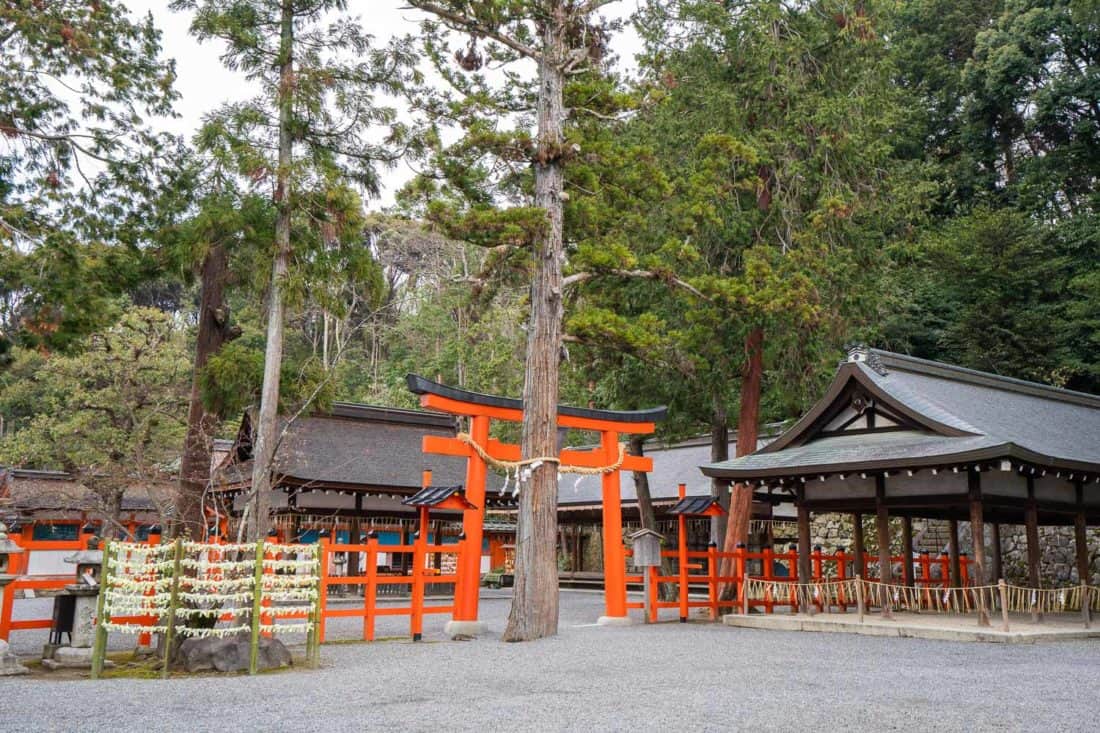
We saw a monk performing a ceremony and there’s a nice collection of sake barrels and some vibrant torii gates.
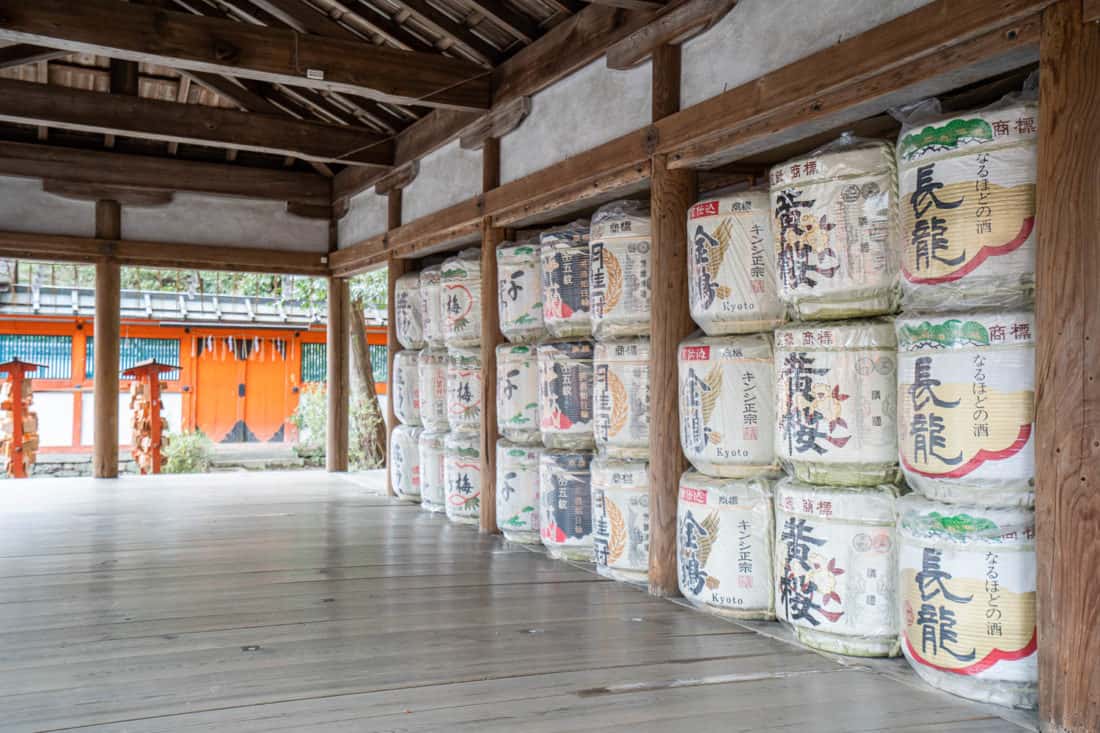
On our way to Shinnyodo Temple we passed Saijōsho Daigengū, a sub-temple of Yoshida-Jinja, which has an attractive thatched roof.
Details: Free entry. It’s best reached on foot—it’s about a 20 minute walk from Ginkaku-ji on the Philosopher’s Path. You could also approach it in the opposite direction from the Kamo River— Demachiyanagi Station is a 20-minute walk away.
14) Shinnyodo Temple
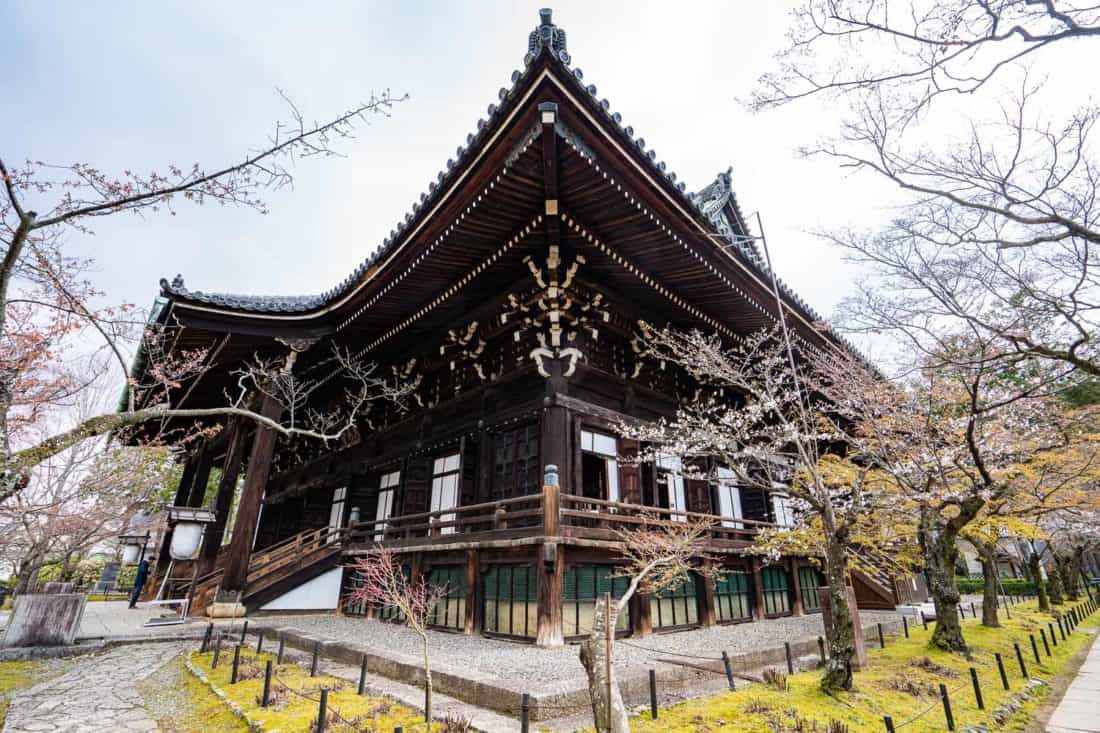
If you make it to Yoshida-Jinja you might as well continue to these next two temples as they are only a 10-minute walk away and are equally quiet (and free).
Shinnyodo is a large temple complex featuring a huge hondo (main hall), various other buildings, and a pond.
There are many cherry trees on the grounds (we were a little too early for the blossoms) and it’s also a beautiful spot in autumn.
To get to the next temple, we walked down the hill through the neighbouring graveyard, which has great views of the city.
Details: Free entry to grounds. Apparently you can pay 500 yen ($4) for the inner chamber and gardens, but this wasn’t obvious to us (or possibly not open). Open 9 am – 4 pm.
15) Konkai-Komyoji (Kurodani)
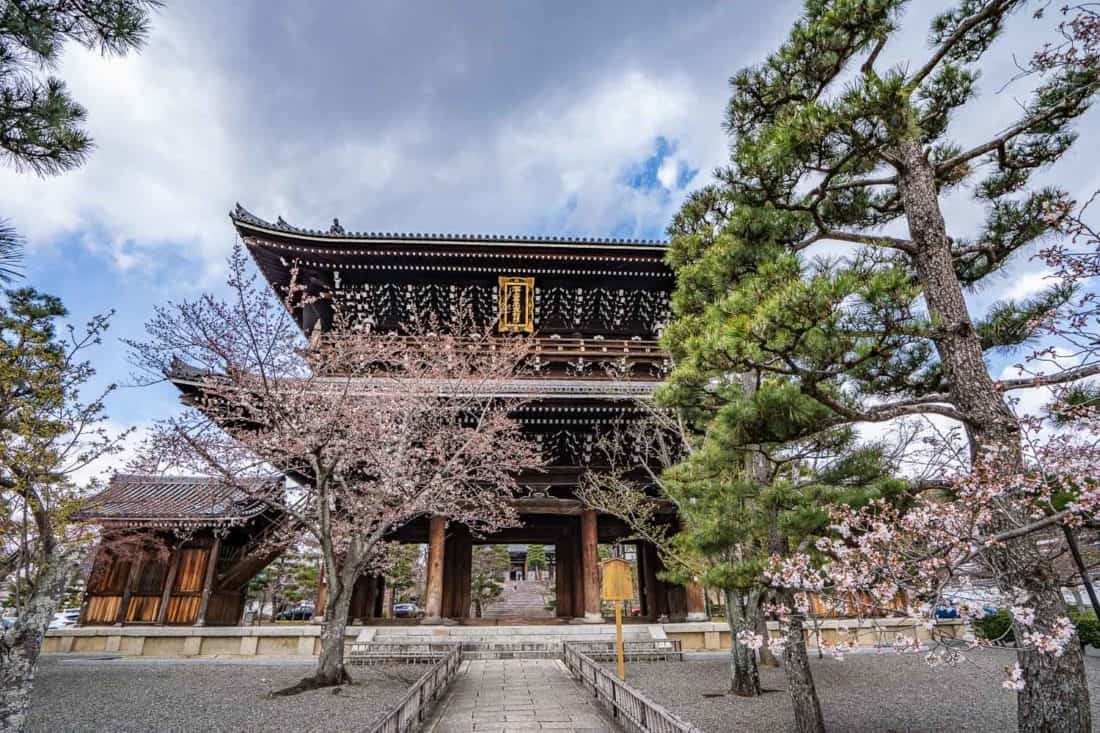
Also known as Kurodani Temple, Konkai-Komyoji is a large complex with an impressive grand entrance gate and staircase lined with cherry trees.
If like us, you arrive via Shinnyodo and the graveyard, you’ll enter from the side and leave through the main entrance.
Amongst the wooden buildings in the complex is a large main hall that was originally built in 1175 and rebuilt in 1605.
Details: Free entry. 600 yen ($4) for back gardens in November. Open 9 am – 4 pm. This was the last of our Yoshida Hill temple tour. We took a taxi to the Kamo River but you could also walk. It’s a 20-minute walk to Jingu-Marutamachi Station.
Southern Kyoto Shrines and Temples
16) Fushimi Inari Taisha
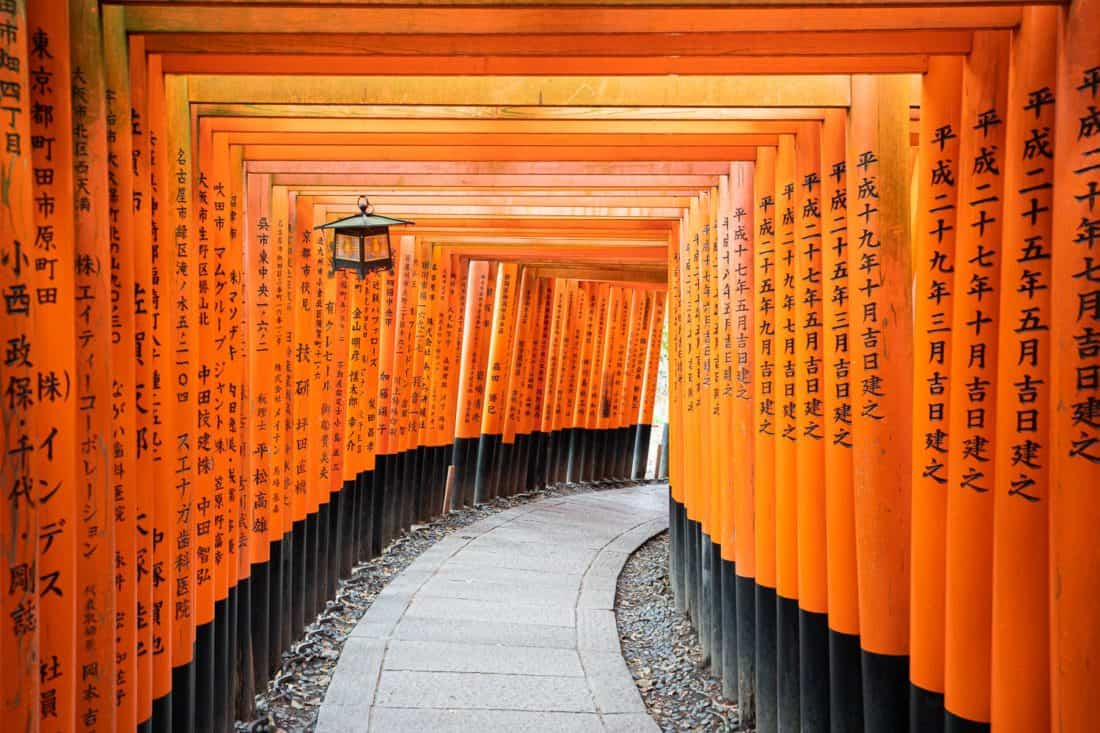
In the far southeast of the city (reached by a short train trip to Inari) is Fushimi Inari Taisha, our favourite Kyoto shrine. If you are a fan of torii gates, this special place is a must.
Thousands of bright orange toriis form passageways and snake up through the forest into the mountains—the orange vibrant against the green backdrop. They just keep going on and on.
It takes us about an hour and a half to complete the circuit, but you could easily spend two or three hours exploring all the little shrines along the way.
Many visitors turn back after the lower loop (at a viewpoint over the city), but I love the upper section deep in the forest as it’s much quieter.
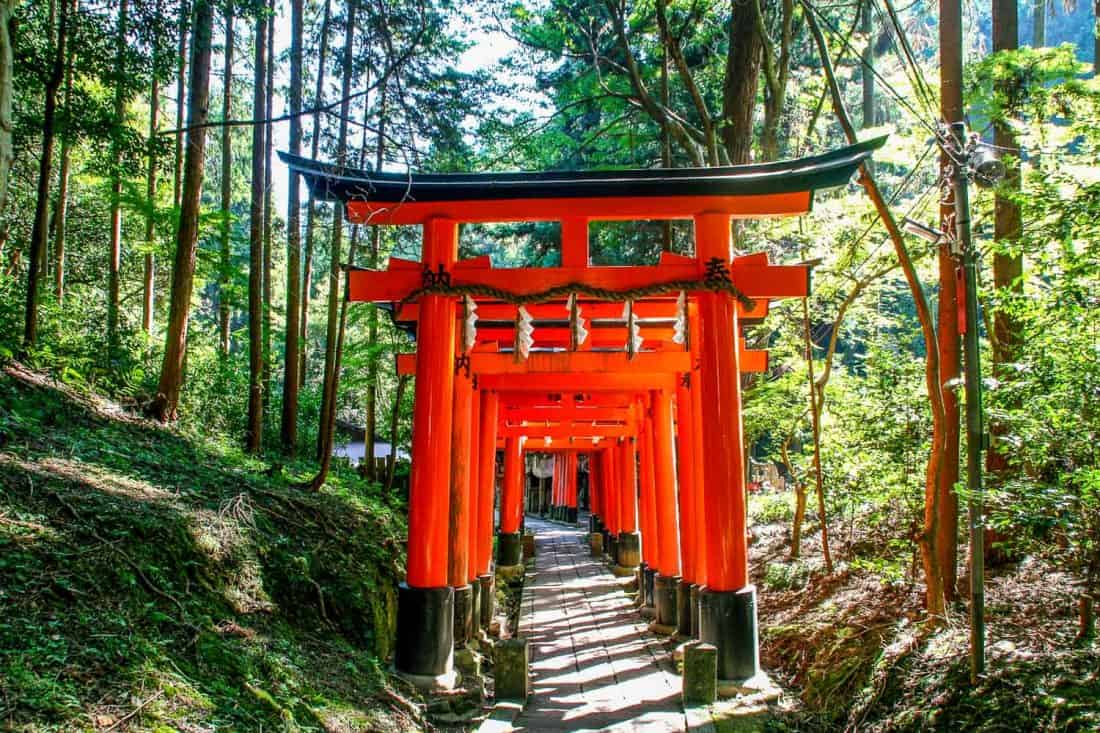
The toriis are donated by individuals and companies, whose names are written on them in black. We saw a sign for this and it costs £3000 to £10,000 depending on the size.
Along the way we passed small shrines with fox stone statues and mini torii gates—the fox is considered the messenger of Inari, the god of the rice harvest. There are also occasional shops and vending machines, but these don’t detract from the magic.
Fushimi Inari is a wonderful place where nature is intertwined with spirituality. Make sure you go early (preferably before 7 am) to experience it in peace as it gets insanely crowded during the day.
You could also visit late at night for a different, atmospheric experience.
Details: Free entry and open 24 hours. Take the train to Fushimi Inari Station on the Keihan Main Line (if coming from Higashiyama, 10 minutes from Gion-Shijo) or JR Inari Station on the JR Nara Line (if coming from Kyoto Station, 5 minutes).
17) Tofuku-ji
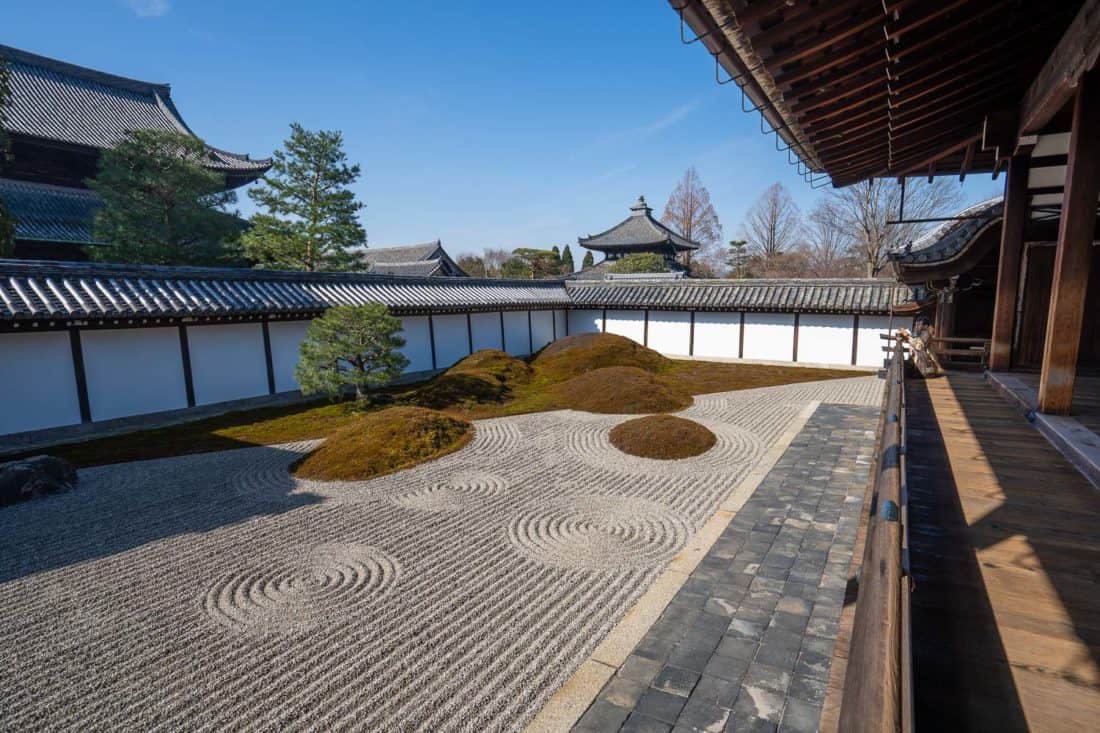
Tofuku-ji is a large Zen temple one train stop (or a 15-minute walk) from the popular Fushimi Inari shrine.
It’s famous for its autumn leaves, and although we enjoyed our spring visit, I don’t think it’s a must-do at other times of year. In autumn, we found the colours impressive, but the crowds were overwhelming, even at opening.
You can wander the grounds for free or pay to enter two areas—the Hojo Gardens and the Tsutenkyo Bridge which leads to the Kaisando Hall.
There are different gardens on each side of the Hojo (the head priest’s former living quarters) including a beautiful rock garden.
Details: Free grounds. 1000 yen ($7) adults/ 500 yen ($3.50) children entry fee for two areas. Open 9 am – 4 pm (from 8.30 am in November and early December). The nearest train station is Tofukuji.
18) Sanjusangendo (Rengeoin)
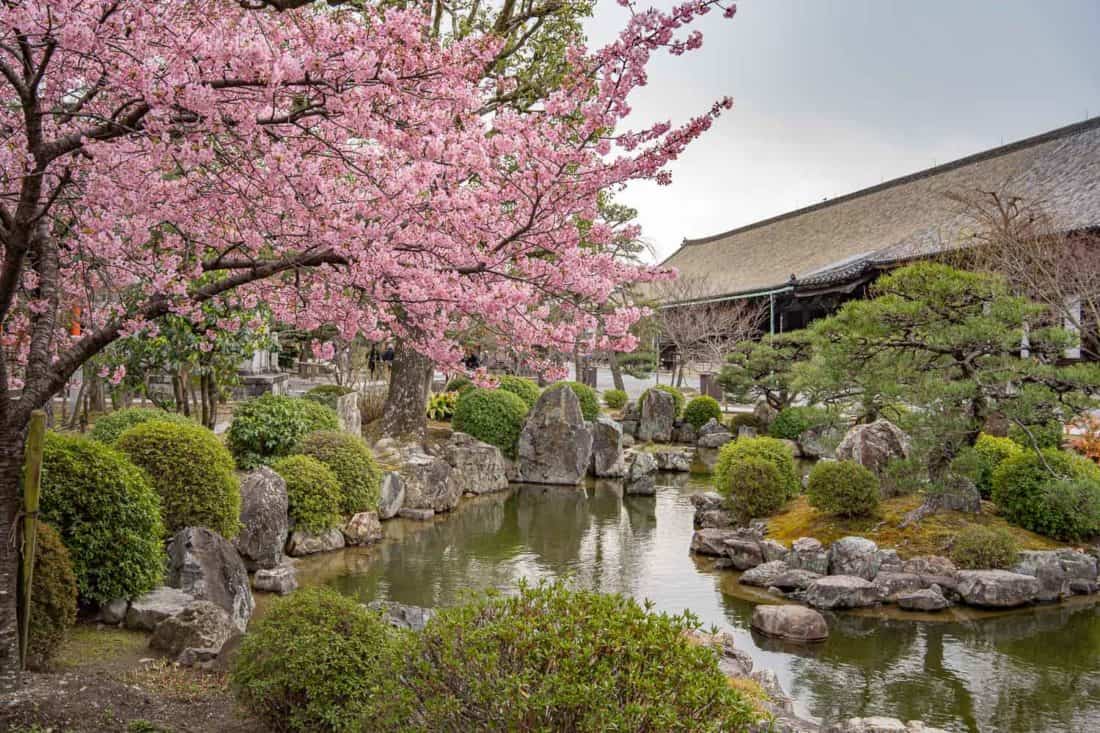
Sanjusangendo is the popular name for Rengeoin temple. It’s located between Southern Higashiyama and Tofuku-ji and is walkable from both.
The 120-metre long temple hall is Japan’s longest wooden structure. It houses 1001 human-sized gold statues of Kannon, the goddess of mercy, along with a giant wooden statue of a 1000-armed Kannon that dates back to the 1200s.
It’s an impressive sight and unlike any other temple in Kyoto.
Details: 600 yen ($4) entry fee. Open 8.30 am – 5 pm (9 am – 4 pm in winter). The nearest train station is Shichijo.
Western Kyoto Temples – Arashiyama
Arashiyama is another of the major traditional neighbourhoods ripe for wandering amongst temples and quiet streets.
It’s up in the western hills and takes a little longer to reach (20 minutes on the train from Kyoto Station to Saga Arashiyama). If you don’t mind walking, you can visit all of these on foot from the station.
19) Tenryu-ji
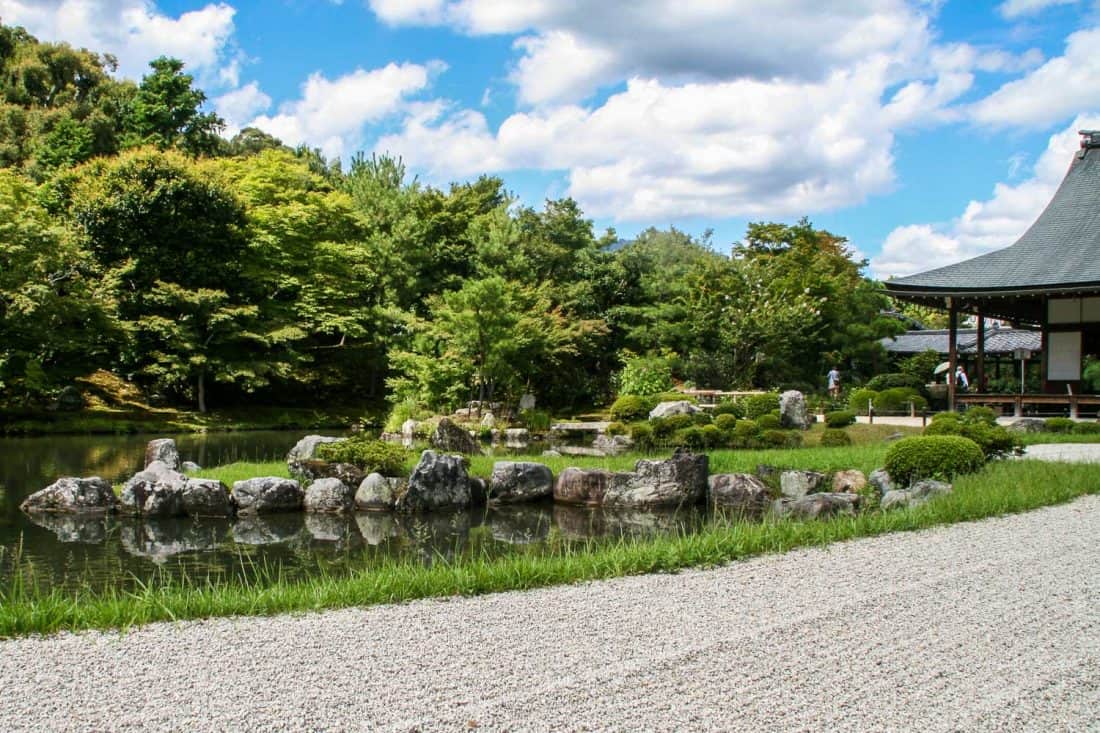
Tenryu-ji is the most important temple in Arashiyama and is a UNESCO world heritage site.
The gardens are the main attraction and include a pond and Zen garden with an overlooking platform where you can sit and contemplate. They are especially lovely in autumn.
This is one of the best places to experience shojin ryori or Zen Buddhist temple cuisine at its restaurant Shigetsu. See my Kyoto vegetarian guide for more details.
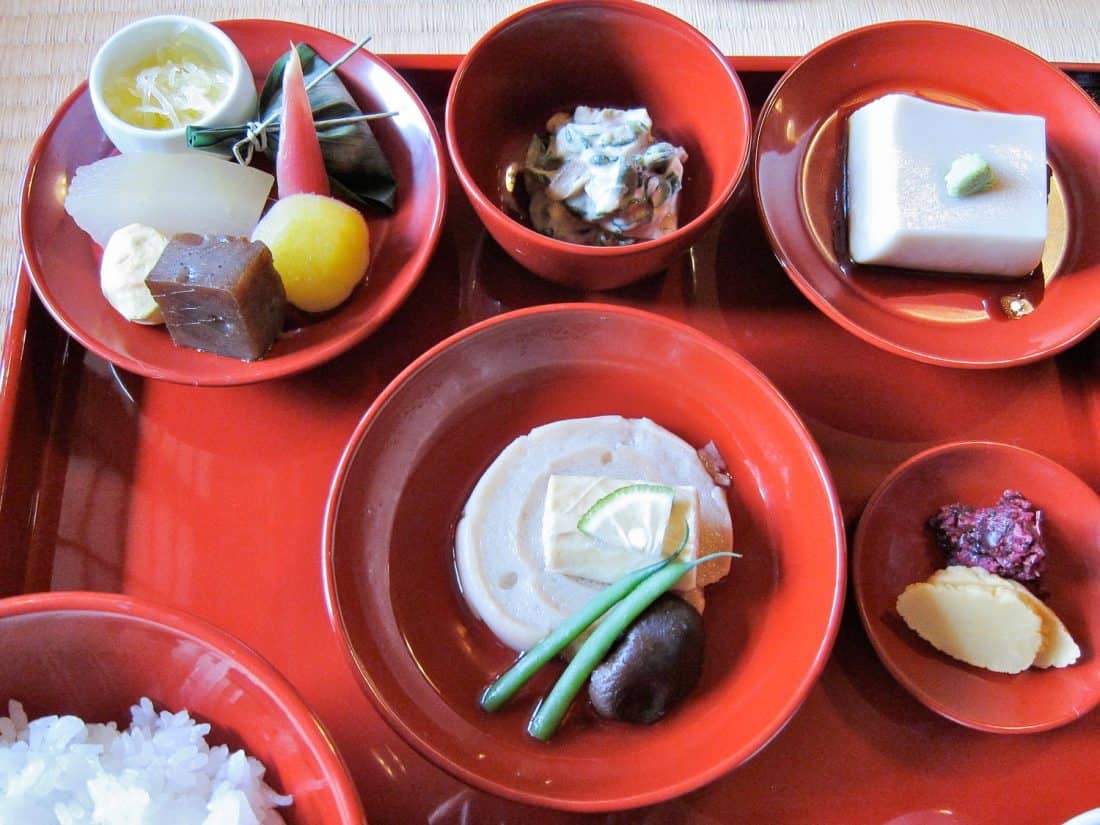
Details: 500 yen ($3.50) adults/ 300 yen ($2) children for garden only entry fee. Open 8.30 am – 5.30 pm.
20) Jojakko-ji
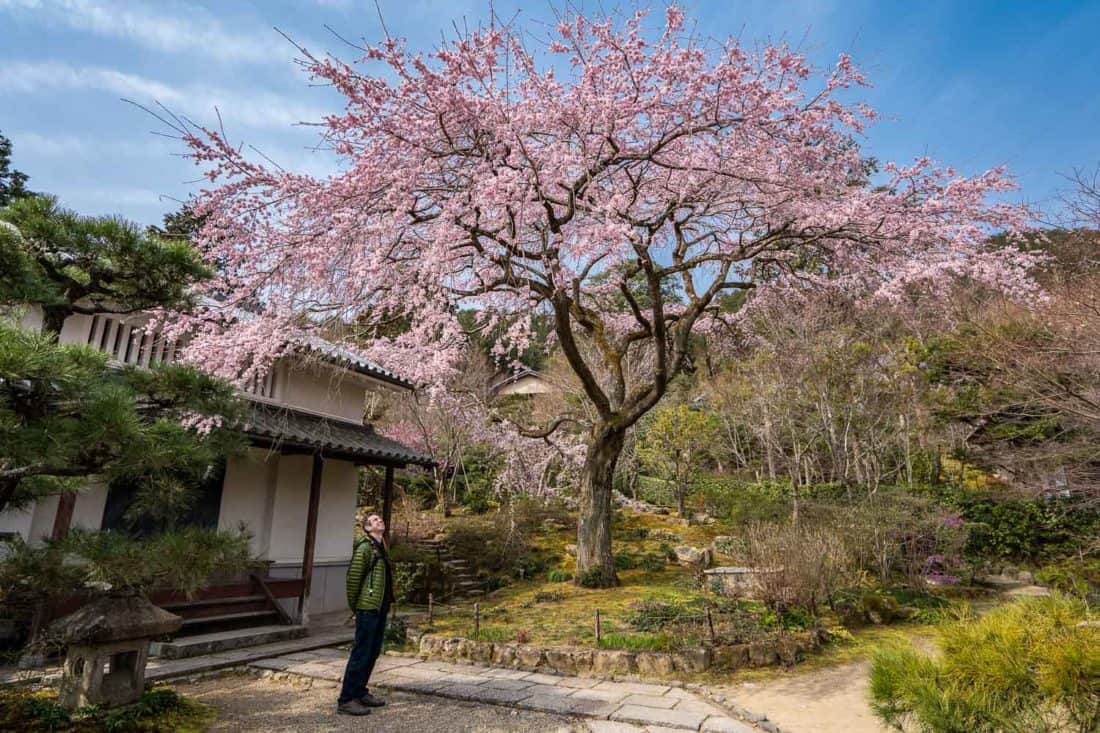
Jojakko-ji is a short walk from Tenryu-ji, but it’s much quieter and is one of my favourite temples in Kyoto.
The hillside gardens are extensive and feature a large cherry tree, mossy roots, small bamboo cluster, a thatched roof gate, and pagoda. There’s a fantastic view of Kyoto from the top.
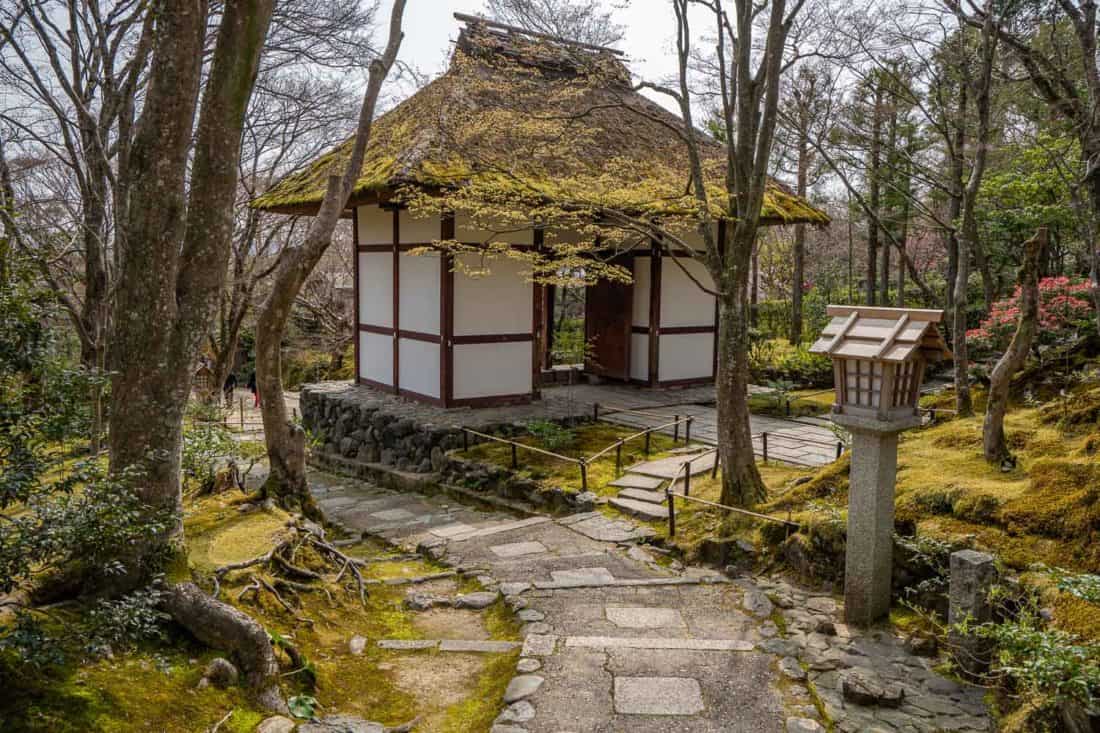
It’s a beautiful temple to visit in autumn, but it’s much busier then.
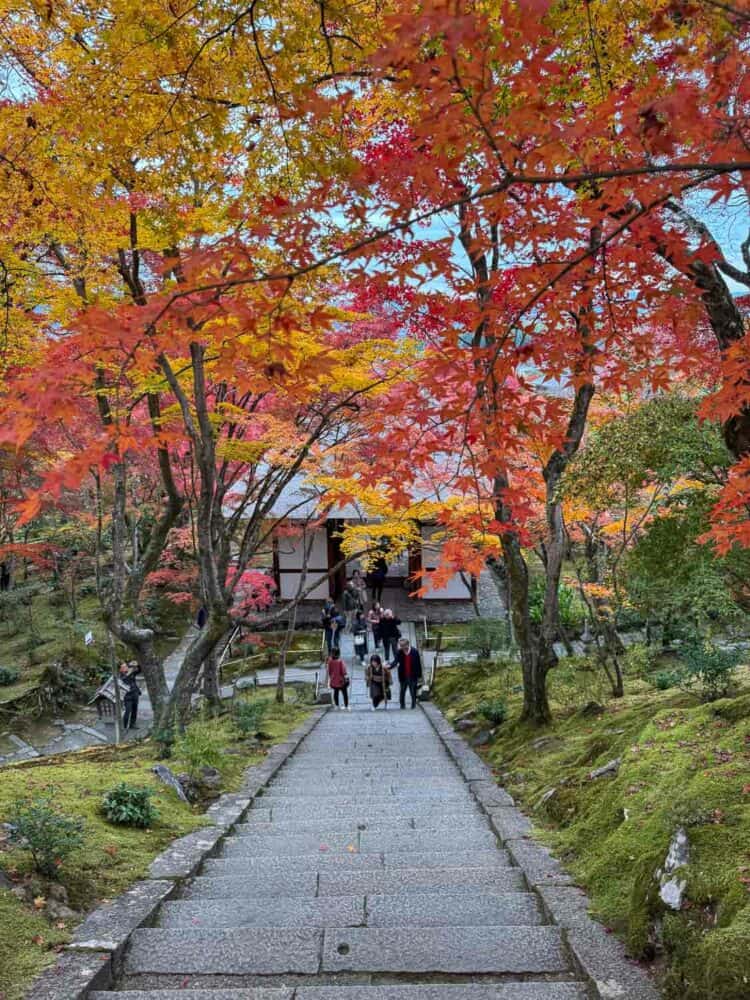
Details: 500 yen ($3.50) entry fee. Open 9 am – 5 pm. It’s a 15-minute walk from Saga Arashiyama station.
21) Gio-ji
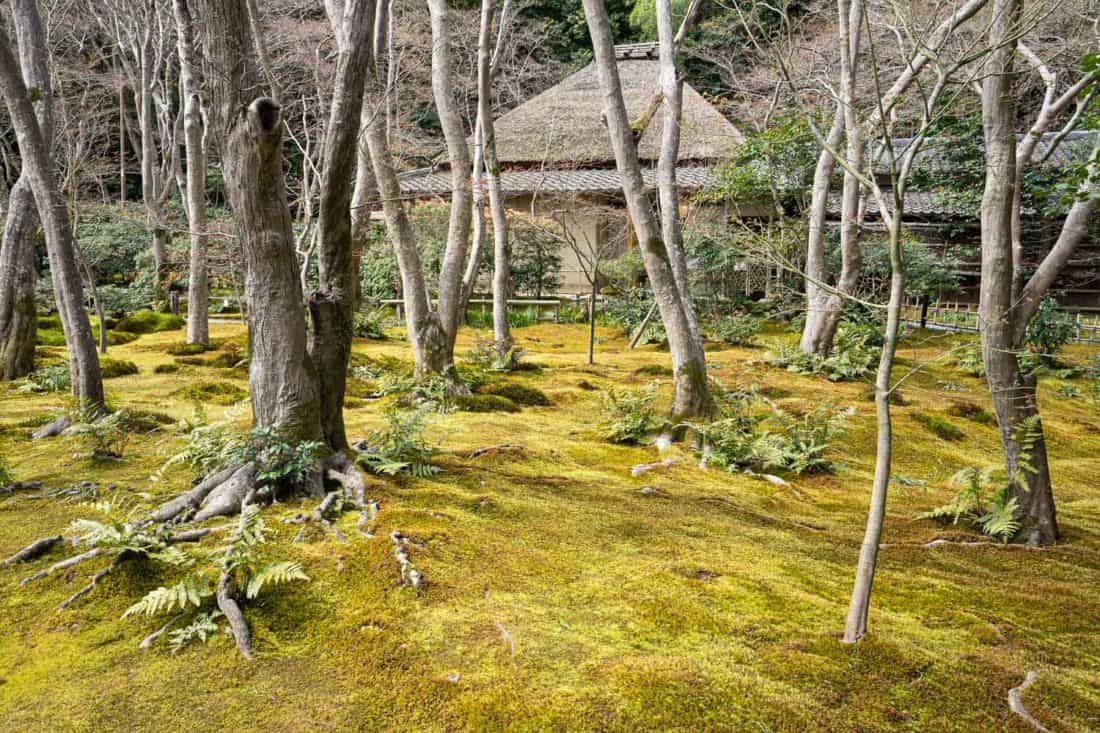
Gio-ji is a lovely small temple with a lush moss garden and a thatched-roof main hall.
It’s usually quiet and is worth a quick stop when wandering through the area, especially if you are planning to visit Daikaku-ji as the combo ticket is good value.
It’s especially beautiful in autumn when the green moss contrasts with the red of the maple trees.
Details: 300 yen ($2) adults/ 100 yen ($1) children entry fee (or 600 yen ($4.50) combo ticket with Daikuku-ji). Open 9 am – 5 pm.
22) Otagi Nenbutsu-ji
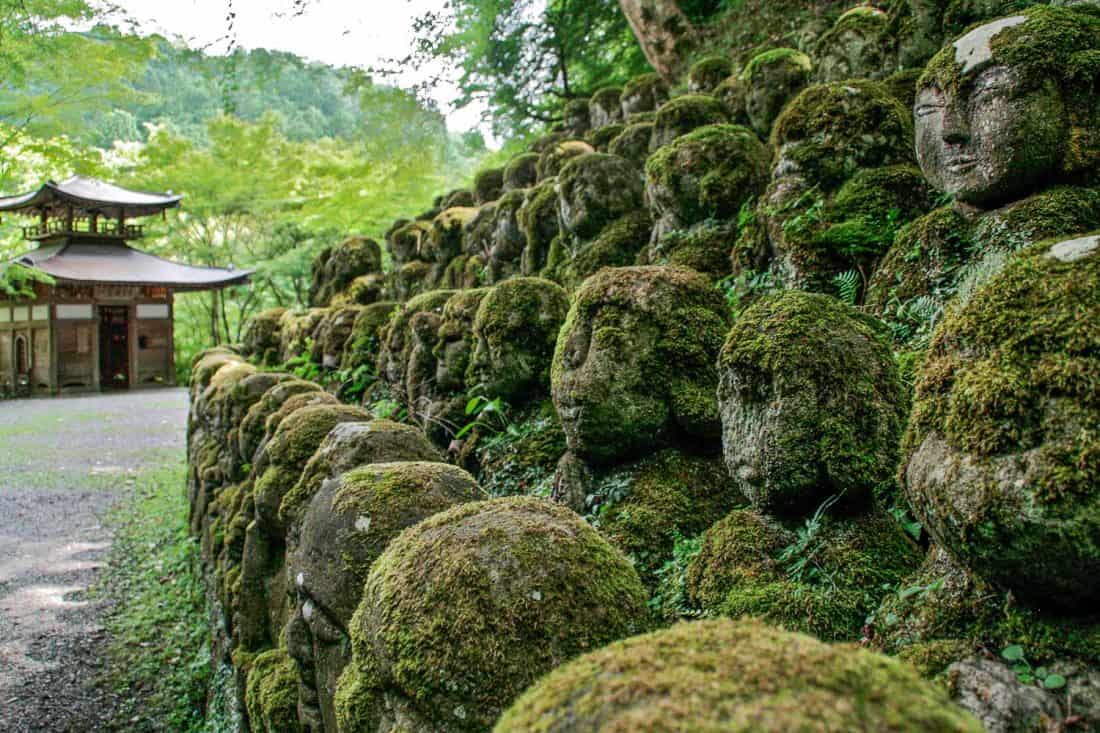
Otagi Nenbutsu-ji is one of our favourite Kyoto temples. It makes the perfect break from the busier temples.
1200 stone sculptures of the Buddha’s disciples are scattered throughout this shady temple complex, all with different facial expressions and poses—scary, serene, cheerful, cute, and just plain bizarre.
Details: 400 yen ($3) adult entry fee, free for under 15 year olds. Open 9 am – 4.30 pm. We walked from the Saga Arashiyama station, which takes about 40 minutes, and there are other temples to visit on the way. There’s also an infrequent bus.
23) Daikaku-ji
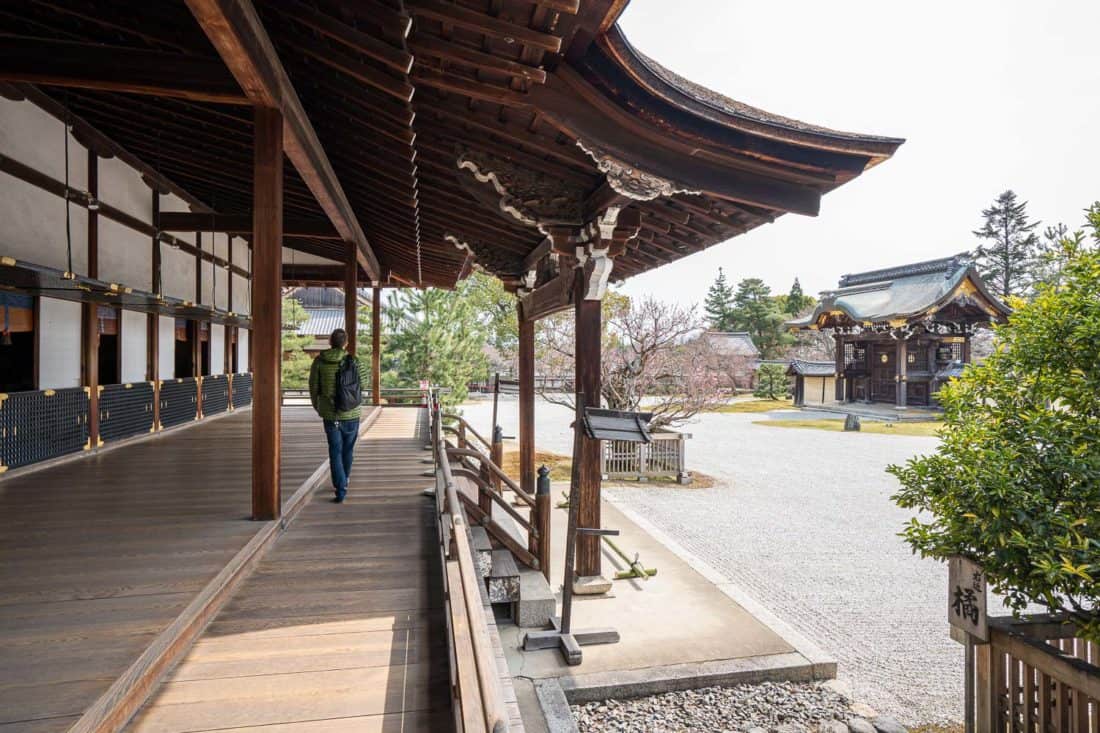
Daikaku-ji is one of Kyoto’s oldest and grandest temples. 1200 years ago it was the imperial palace of Emperor Saga before being converted to a temple after his death.
It’s a huge complex with multiple wooden halls overlooking a large gravel garden. It’s rich in history, culture, and art including a copy of the important Heart Sutra written by the emperor. You can even try copying your own sutra for an extra fee.
Outside there’s a large pond lined with cherry trees. At the end of March, they were only just starting to bloom, but in the height of sakura season, you don’t want to miss it. It’s also stunning in autumn.
Details: 500 yen ($3.50) adults/ 300 yen ($2) children entry fee for temple or 300 yen ($2) adults/ 100 yen ($1) children for just gardens (or 600 yen ($4) combo ticket with Gio-ji). Open 9 am – 5 pm.
24) Saihoji Moss Temple
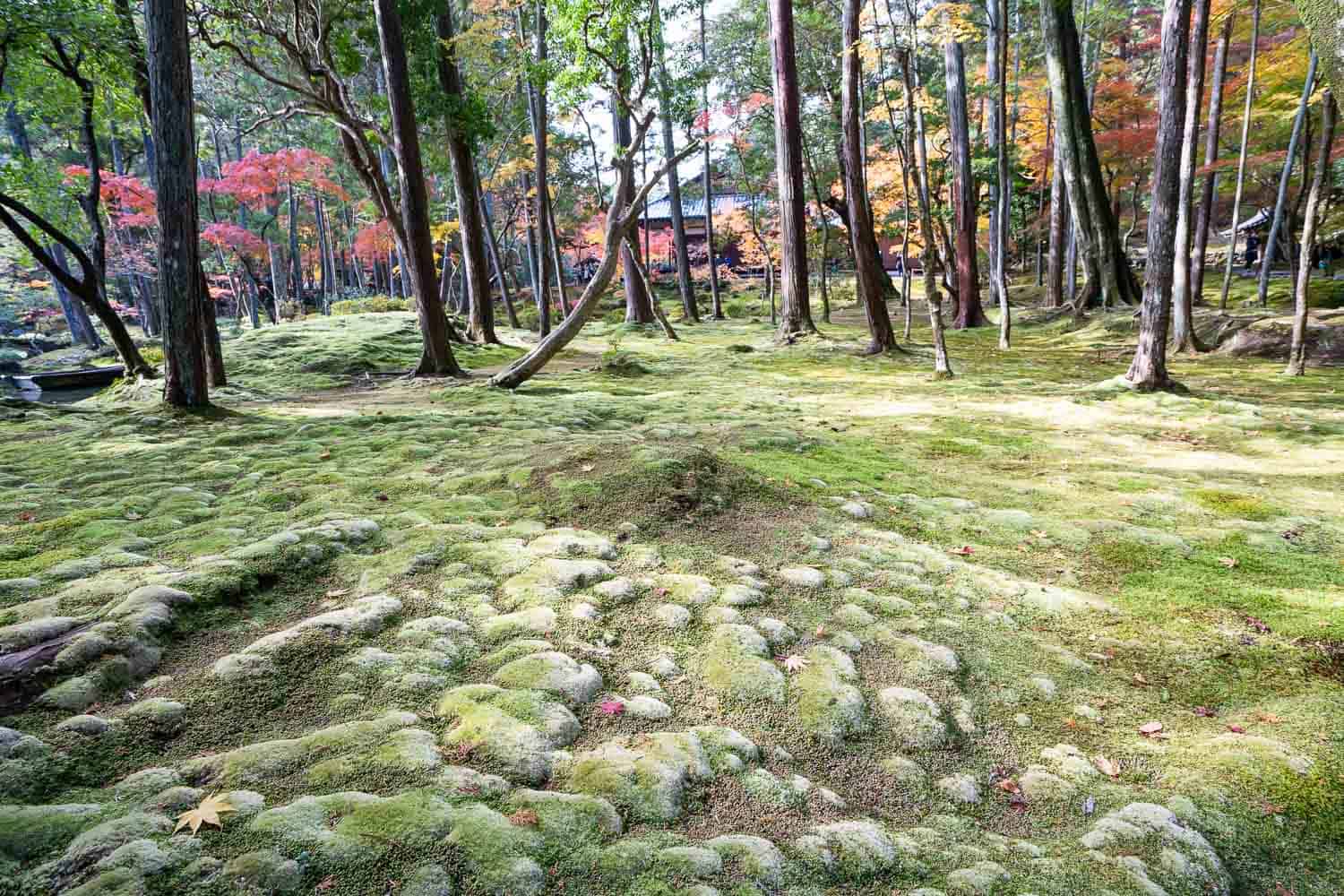
Saihoji aka the Kyoto Moss Temple is our new favourite temple in Kyoto. On previous trips we were put off visiting by the reservation system that required sending a postcard. Thankfully, you can now book online.
It’s the most expensive temple in Kyoto, but we absolutely loved it. As visitor numbers are limited, it feels much more peaceful than other popular temples, especially as you start your visit with a mindful sutra copying exercise.
The vibrant mossy gardens surrounding a pond are gorgeous, especially contrasted with the red maples in autumn. The moss is greenest after the early summer rain, though.
This is a temple to visit for the gardens more than the buildings.
See our guide to Saihoji Moss Temple for more information and photos.
Details: Entrance costs 4000 yen ($28). Bookings are essential on the Saihoji website. Opening hours vary. It’s south of Arashiyama and you can get a bus or taxi between the two (15 minutes).
Nara Temples
Nara makes an easy day trip from Kyoto (35 minutes on the fastest train) and there are many temples to explore.
We spent a morning wandering amongst the deer in Nara Park and visiting temples along the way. See our guide to the best Kyoto day trips for more places to visit in Nara.
25) Todai-ji
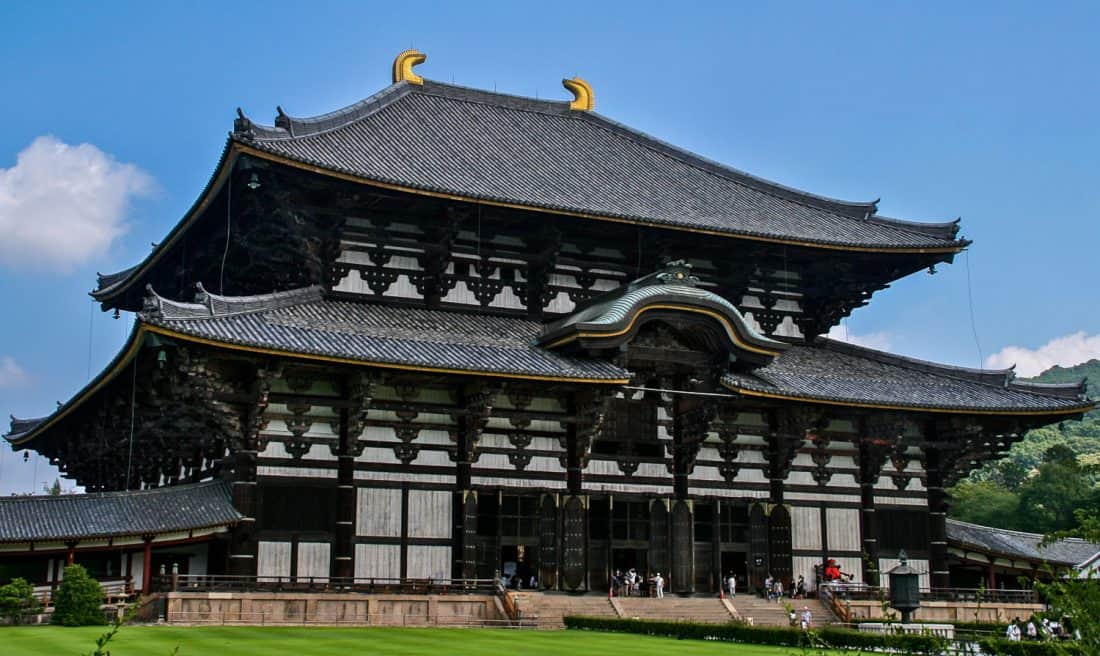
Todai-ji is the main attraction in Nara and rightly so. The Daibutsu-den (Hall of the Great Buddha) is the largest wooden building in the world and nothing prepares you for the immense sight.
Inside is the Giant Buddha, known in Japan as Daibutsu. This gold and bronze buddha is one of the largest bronze statues in the world at 16 metres tall and dates all the way back to 746.
Details: 800 yen ($6) entry fee, 300 yen ($2) for those under 12 years olds. Open 7.30 am – 5.30 pm (April – October) and 8 am – 5 pm in the winter.
The nearest station is Kintetsu Nara Station, but if you are travelling with a Japan Rail Pass, you’ll need to go to JR Nara Station, which is a 40-minute walk from the temple—you can see the deer in Nara Park on the way.
Kyoto Temples and Shrines Map
Summary
Before we first arrived in Kyoto, I was a little overwhelmed by how many temples and shrines there were to visit. I was sure we’d get templed out after a while, but we really enjoyed all of our temple explorations.
On every visit to Kyoto, we keep discovering even more beautiful temples. Every season is different too.
Make sure to combine the famous temples with a few hidden gems so that the crowds don’t get overwhelming.
More Japan Posts
Read more of our Kyoto and Japan travel tips.
Kyoto
- 31 Unforgettable Things to Do in Kyoto, Japan
- Where to Stay in Kyoto: Recommended Hotels and Areas
- 14 Stunning Places to See the Cherry Blossoms in Kyoto
- 10 Stunning Autumn Leaf Spots in Kyoto
- 20 Best Vegetarian Restaurants in Kyoto
- 15 Best Day Trips from Kyoto
General Japan Tips
- Planning a Trip to Japan: Dos and Don’ts
- 16 Unmissable Places to Visit in Japan
- Two Weeks in Japan: A Detailed Itinerary
- 56 Best Things to Do in Japan for an Unforgettable Trip
If you enjoyed this post, pin it!
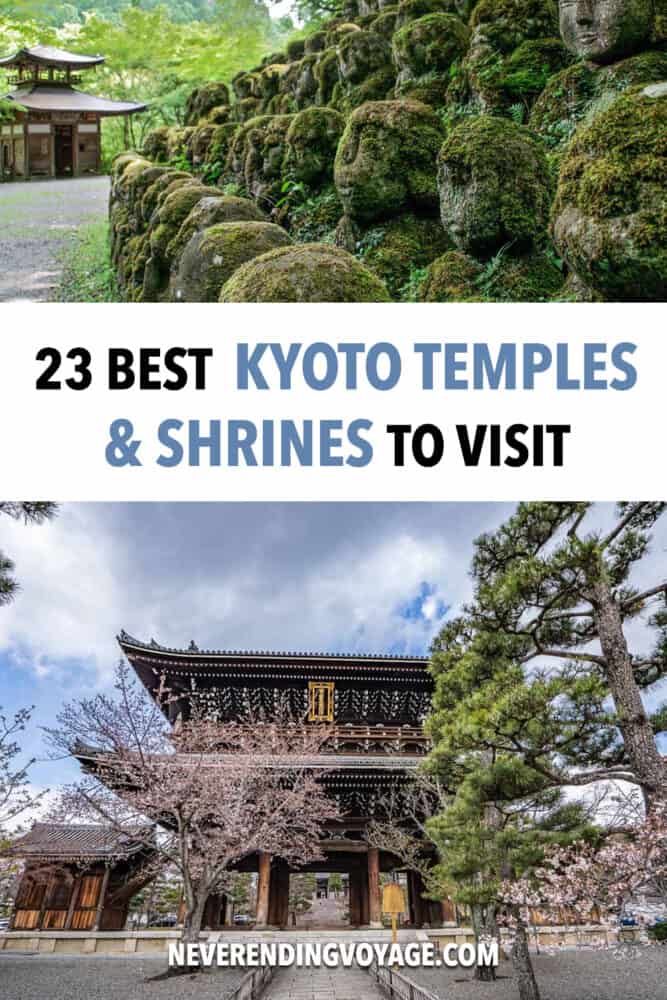
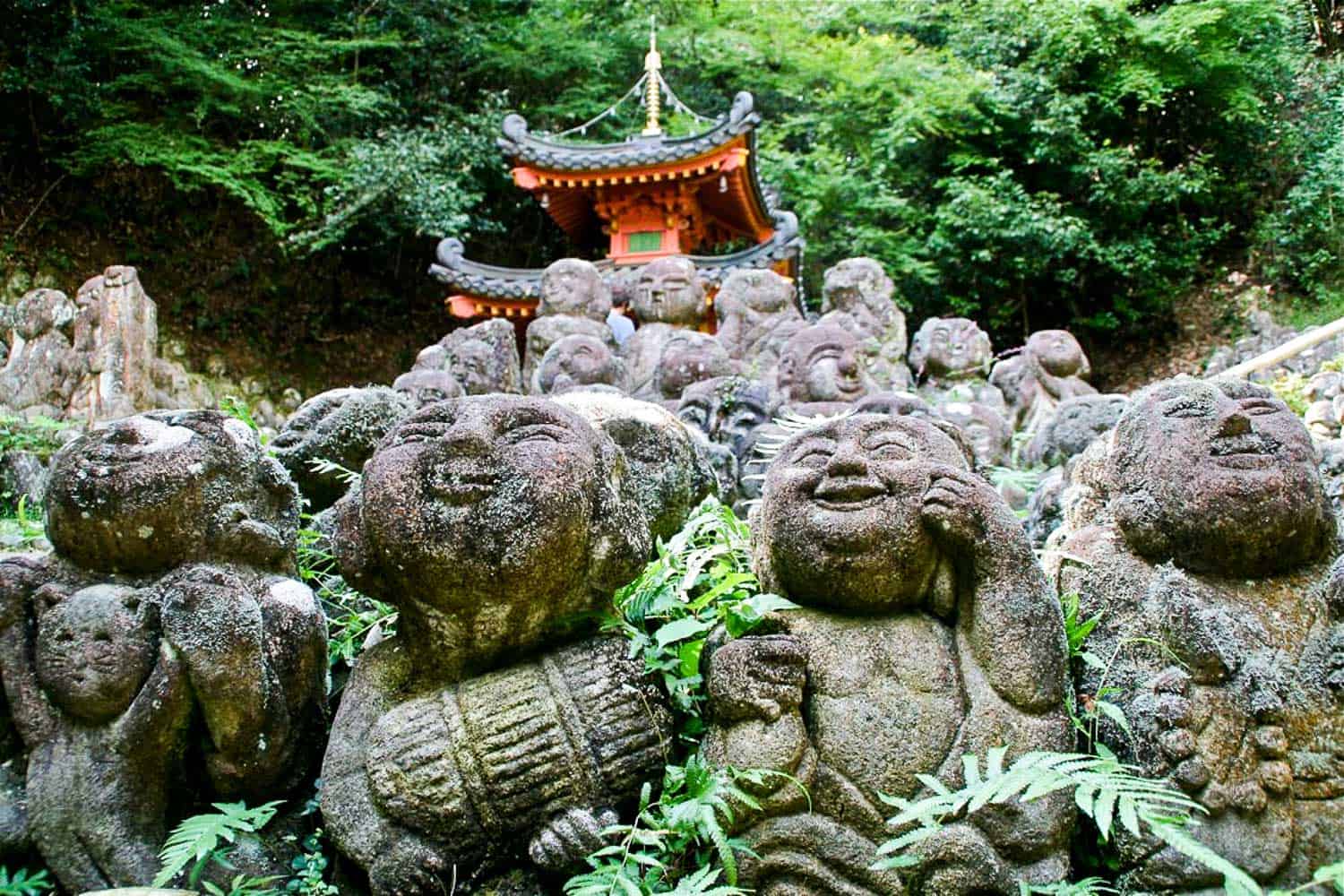
Hi, just wanted to say thanks for this post. I love your suggestions, find it more helpful than lonely planet guide and it’s always nice to see pics that go with them.
I am looking forward to our first trip to Kyoto and you made my planning much easier.
Keep on travelling and sharing!
Thanks again
Aw, thanks for the kind words, Elena and enjoy Kyoto!
The ‘cost’ is for the entrance to the temple? OMG I thought its free.
Superb! It took me 3 years to get a hang of the temples and shrines of this great city. Still may more of these to discover and explore!
Thank you
Just seen your web page.
Having just returned from Kyoto it brought back happy memories for me and answered a few questions too…so thankyou!
For those considering a first visit….do not hesitate,GO!! (check best season first though).
I would like to visit Kyoto one of these days. Wonderful pictures and thank you for the descriptions of each temple.
Thank you! Wonderful blog. We will be going to Kyoto in a few days and definitely will use this blog as reference!! Thank you!!
Thanks Wini and have a great trip!
beautiful photos n amazing tokyo’s tamples
nice story… i like it , and it make me wanna going there too..
^_^
Wow what a great temple guide! My boyfriend and I are starting off our 2 year backpacking trip in Japan this fall so I’ll definitely be going back to this post to see which temples we should visit!
I’m glad you found it useful Vicky. Japan has the best temples of any country we’ve been to in Asia (and we’ve seen some gorgeous ones in Thailand too).
Hello, i think that i noticed you visited my site thus i got here to “return the prefer”.I am trying to in finding issues to improve my web site!I assume its good enough to make use of some of your ideas!!
Love this essay! Nice of the weather to participate, too!
Thanks Erik. We did have a typhoon during our stay in Kyoto, but as we were there for 3.5 weeks we could choose the nice days to go out and explore.
What an amazing summary of temples to visit when in Kyoto ~
And gorgeous photos… very luring :)
We would really recommend a visit!